The Assignment on Planning & Assessment Processes
VerifiedAdded on 2022/08/23
|23
|4799
|18
AI Summary
Contribute Materials
Your contribution can guide someone’s learning journey. Share your
documents today.

Planning & Assessment Processes1
PLANNING AND ASSESSMENT PROCESSES
Name of the student
Course
Date
PLANNING AND ASSESSMENT PROCESSES
Name of the student
Course
Date
Secure Best Marks with AI Grader
Need help grading? Try our AI Grader for instant feedback on your assignments.
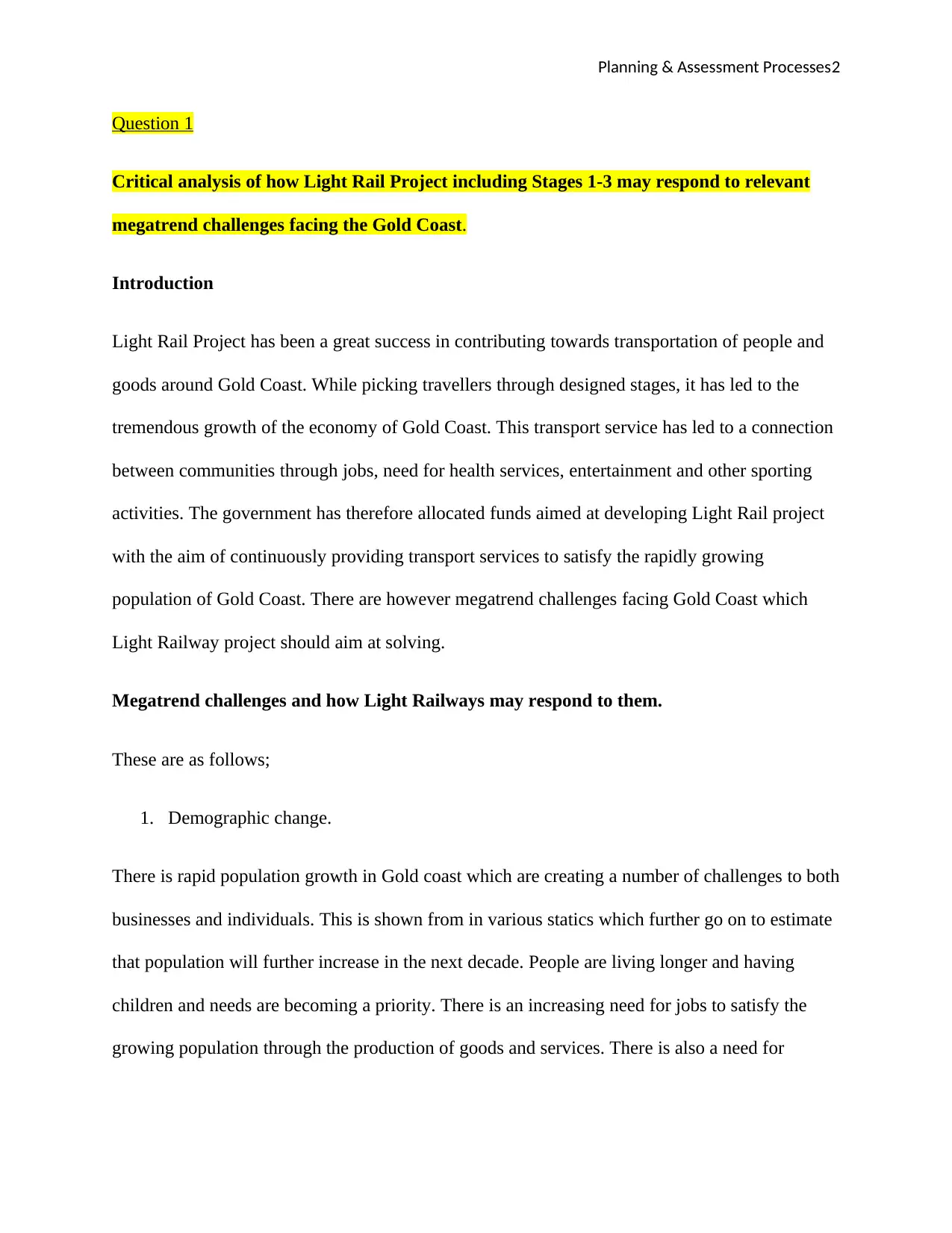
Planning & Assessment Processes2
Question 1
Critical analysis of how Light Rail Project including Stages 1-3 may respond to relevant
megatrend challenges facing the Gold Coast.
Introduction
Light Rail Project has been a great success in contributing towards transportation of people and
goods around Gold Coast. While picking travellers through designed stages, it has led to the
tremendous growth of the economy of Gold Coast. This transport service has led to a connection
between communities through jobs, need for health services, entertainment and other sporting
activities. The government has therefore allocated funds aimed at developing Light Rail project
with the aim of continuously providing transport services to satisfy the rapidly growing
population of Gold Coast. There are however megatrend challenges facing Gold Coast which
Light Railway project should aim at solving.
Megatrend challenges and how Light Railways may respond to them.
These are as follows;
1. Demographic change.
There is rapid population growth in Gold coast which are creating a number of challenges to both
businesses and individuals. This is shown from in various statics which further go on to estimate
that population will further increase in the next decade. People are living longer and having
children and needs are becoming a priority. There is an increasing need for jobs to satisfy the
growing population through the production of goods and services. There is also a need for
Question 1
Critical analysis of how Light Rail Project including Stages 1-3 may respond to relevant
megatrend challenges facing the Gold Coast.
Introduction
Light Rail Project has been a great success in contributing towards transportation of people and
goods around Gold Coast. While picking travellers through designed stages, it has led to the
tremendous growth of the economy of Gold Coast. This transport service has led to a connection
between communities through jobs, need for health services, entertainment and other sporting
activities. The government has therefore allocated funds aimed at developing Light Rail project
with the aim of continuously providing transport services to satisfy the rapidly growing
population of Gold Coast. There are however megatrend challenges facing Gold Coast which
Light Railway project should aim at solving.
Megatrend challenges and how Light Railways may respond to them.
These are as follows;
1. Demographic change.
There is rapid population growth in Gold coast which are creating a number of challenges to both
businesses and individuals. This is shown from in various statics which further go on to estimate
that population will further increase in the next decade. People are living longer and having
children and needs are becoming a priority. There is an increasing need for jobs to satisfy the
growing population through the production of goods and services. There is also a need for
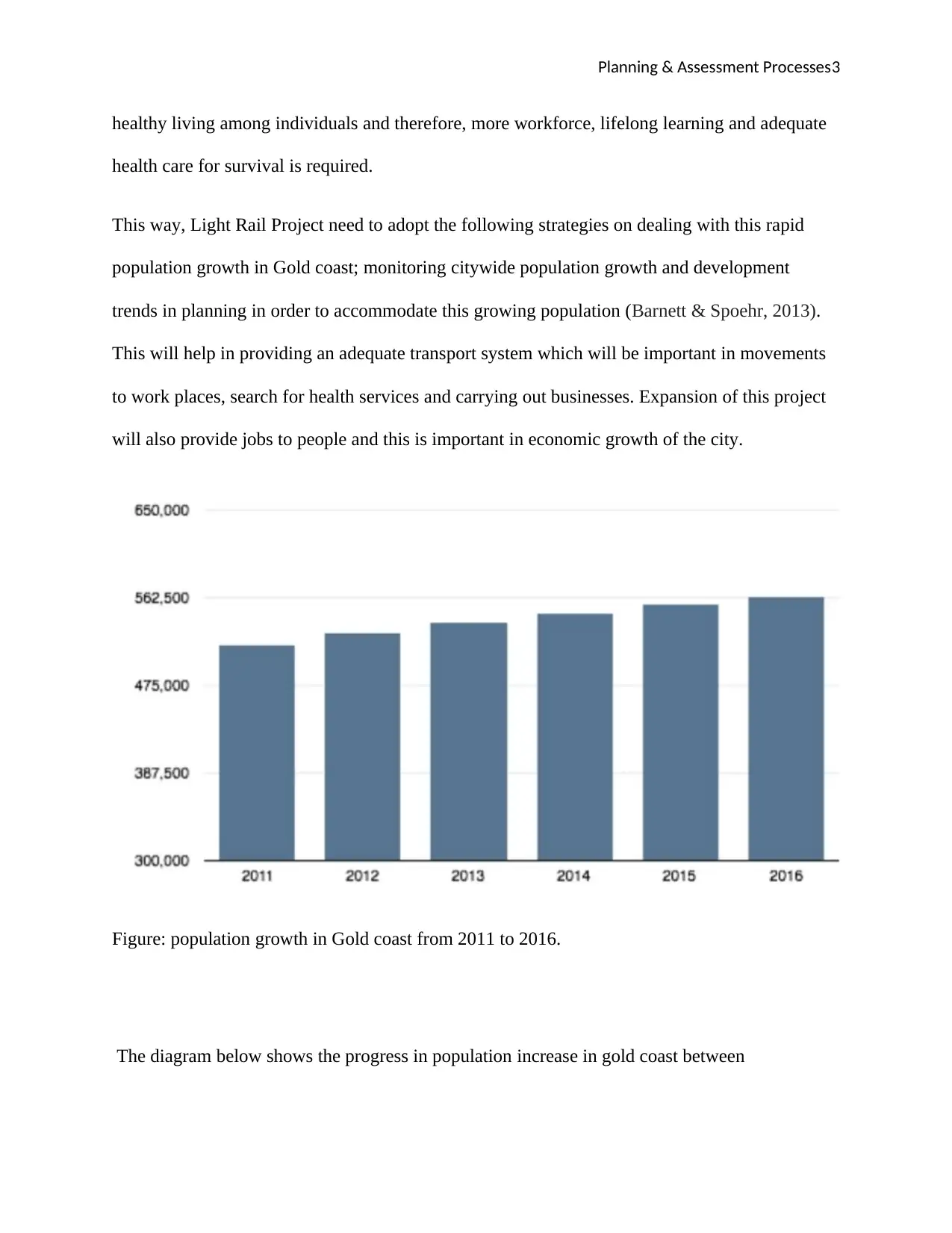
Planning & Assessment Processes3
healthy living among individuals and therefore, more workforce, lifelong learning and adequate
health care for survival is required.
This way, Light Rail Project need to adopt the following strategies on dealing with this rapid
population growth in Gold coast; monitoring citywide population growth and development
trends in planning in order to accommodate this growing population (Barnett & Spoehr, 2013).
This will help in providing an adequate transport system which will be important in movements
to work places, search for health services and carrying out businesses. Expansion of this project
will also provide jobs to people and this is important in economic growth of the city.
Figure: population growth in Gold coast from 2011 to 2016.
The diagram below shows the progress in population increase in gold coast between
healthy living among individuals and therefore, more workforce, lifelong learning and adequate
health care for survival is required.
This way, Light Rail Project need to adopt the following strategies on dealing with this rapid
population growth in Gold coast; monitoring citywide population growth and development
trends in planning in order to accommodate this growing population (Barnett & Spoehr, 2013).
This will help in providing an adequate transport system which will be important in movements
to work places, search for health services and carrying out businesses. Expansion of this project
will also provide jobs to people and this is important in economic growth of the city.
Figure: population growth in Gold coast from 2011 to 2016.
The diagram below shows the progress in population increase in gold coast between
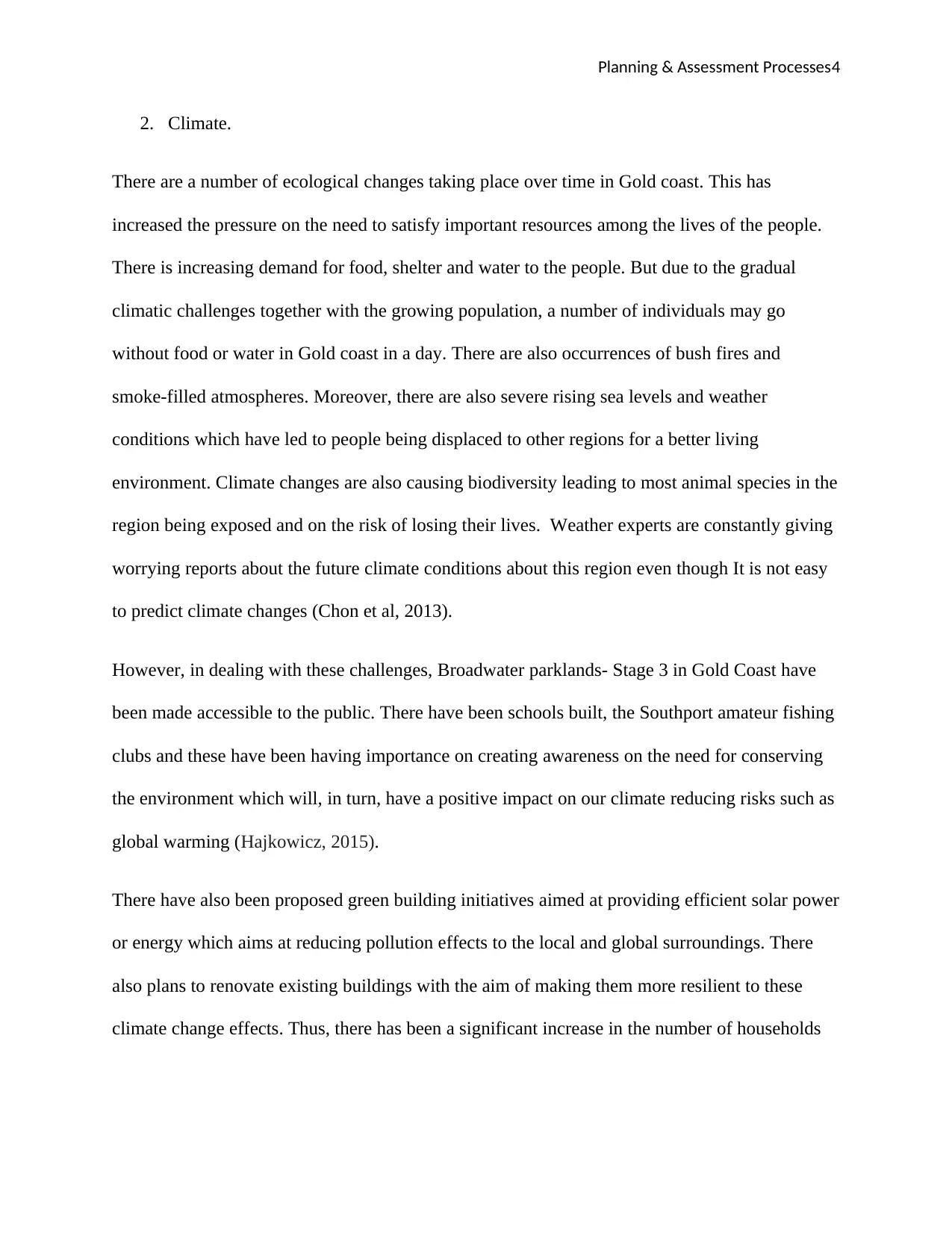
Planning & Assessment Processes4
2. Climate.
There are a number of ecological changes taking place over time in Gold coast. This has
increased the pressure on the need to satisfy important resources among the lives of the people.
There is increasing demand for food, shelter and water to the people. But due to the gradual
climatic challenges together with the growing population, a number of individuals may go
without food or water in Gold coast in a day. There are also occurrences of bush fires and
smoke-filled atmospheres. Moreover, there are also severe rising sea levels and weather
conditions which have led to people being displaced to other regions for a better living
environment. Climate changes are also causing biodiversity leading to most animal species in the
region being exposed and on the risk of losing their lives. Weather experts are constantly giving
worrying reports about the future climate conditions about this region even though It is not easy
to predict climate changes (Chon et al, 2013).
However, in dealing with these challenges, Broadwater parklands- Stage 3 in Gold Coast have
been made accessible to the public. There have been schools built, the Southport amateur fishing
clubs and these have been having importance on creating awareness on the need for conserving
the environment which will, in turn, have a positive impact on our climate reducing risks such as
global warming (Hajkowicz, 2015).
There have also been proposed green building initiatives aimed at providing efficient solar power
or energy which aims at reducing pollution effects to the local and global surroundings. There
also plans to renovate existing buildings with the aim of making them more resilient to these
climate change effects. Thus, there has been a significant increase in the number of households
2. Climate.
There are a number of ecological changes taking place over time in Gold coast. This has
increased the pressure on the need to satisfy important resources among the lives of the people.
There is increasing demand for food, shelter and water to the people. But due to the gradual
climatic challenges together with the growing population, a number of individuals may go
without food or water in Gold coast in a day. There are also occurrences of bush fires and
smoke-filled atmospheres. Moreover, there are also severe rising sea levels and weather
conditions which have led to people being displaced to other regions for a better living
environment. Climate changes are also causing biodiversity leading to most animal species in the
region being exposed and on the risk of losing their lives. Weather experts are constantly giving
worrying reports about the future climate conditions about this region even though It is not easy
to predict climate changes (Chon et al, 2013).
However, in dealing with these challenges, Broadwater parklands- Stage 3 in Gold Coast have
been made accessible to the public. There have been schools built, the Southport amateur fishing
clubs and these have been having importance on creating awareness on the need for conserving
the environment which will, in turn, have a positive impact on our climate reducing risks such as
global warming (Hajkowicz, 2015).
There have also been proposed green building initiatives aimed at providing efficient solar power
or energy which aims at reducing pollution effects to the local and global surroundings. There
also plans to renovate existing buildings with the aim of making them more resilient to these
climate change effects. Thus, there has been a significant increase in the number of households
Secure Best Marks with AI Grader
Need help grading? Try our AI Grader for instant feedback on your assignments.
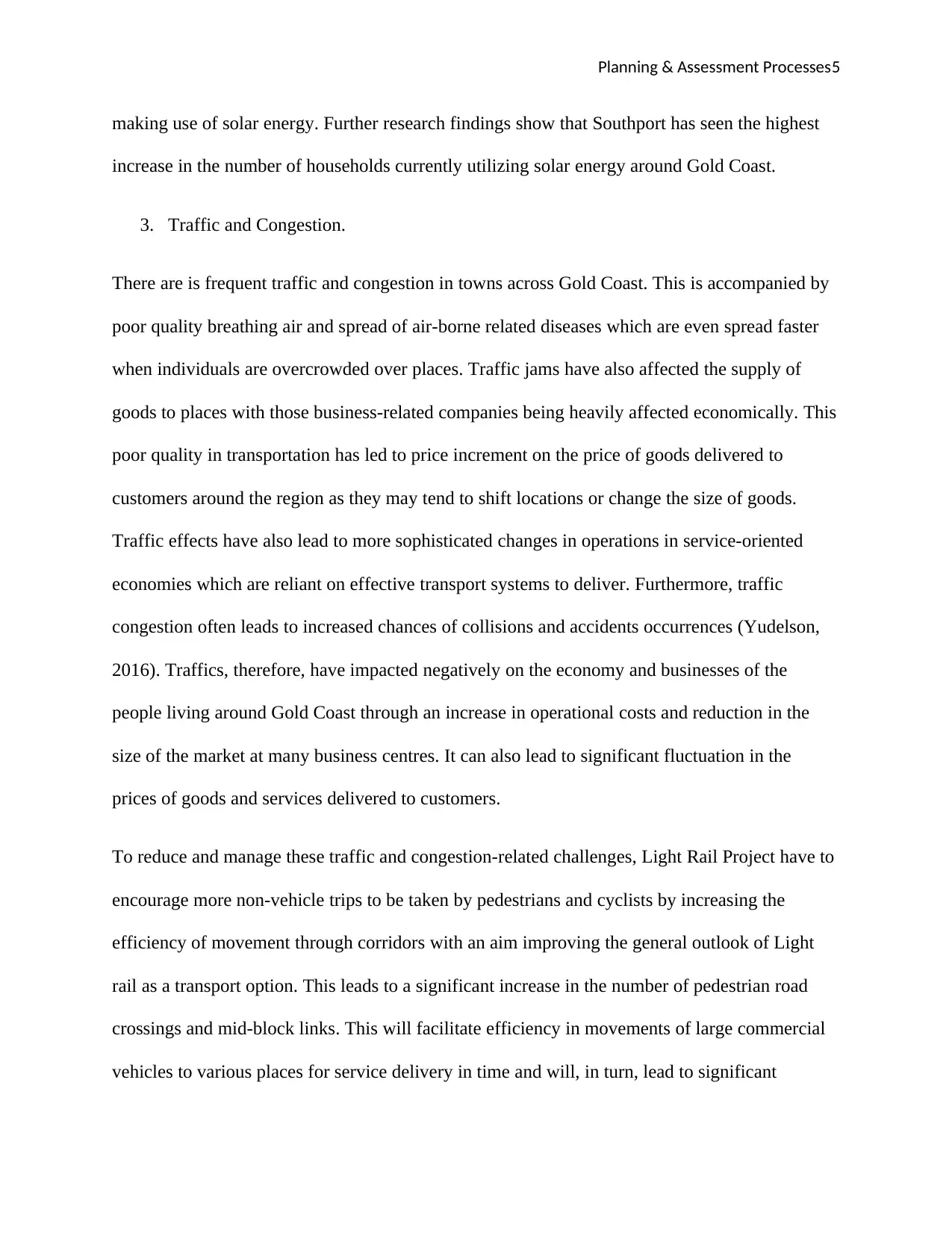
Planning & Assessment Processes5
making use of solar energy. Further research findings show that Southport has seen the highest
increase in the number of households currently utilizing solar energy around Gold Coast.
3. Traffic and Congestion.
There are is frequent traffic and congestion in towns across Gold Coast. This is accompanied by
poor quality breathing air and spread of air-borne related diseases which are even spread faster
when individuals are overcrowded over places. Traffic jams have also affected the supply of
goods to places with those business-related companies being heavily affected economically. This
poor quality in transportation has led to price increment on the price of goods delivered to
customers around the region as they may tend to shift locations or change the size of goods.
Traffic effects have also lead to more sophisticated changes in operations in service-oriented
economies which are reliant on effective transport systems to deliver. Furthermore, traffic
congestion often leads to increased chances of collisions and accidents occurrences (Yudelson,
2016). Traffics, therefore, have impacted negatively on the economy and businesses of the
people living around Gold Coast through an increase in operational costs and reduction in the
size of the market at many business centres. It can also lead to significant fluctuation in the
prices of goods and services delivered to customers.
To reduce and manage these traffic and congestion-related challenges, Light Rail Project have to
encourage more non-vehicle trips to be taken by pedestrians and cyclists by increasing the
efficiency of movement through corridors with an aim improving the general outlook of Light
rail as a transport option. This leads to a significant increase in the number of pedestrian road
crossings and mid-block links. This will facilitate efficiency in movements of large commercial
vehicles to various places for service delivery in time and will, in turn, lead to significant
making use of solar energy. Further research findings show that Southport has seen the highest
increase in the number of households currently utilizing solar energy around Gold Coast.
3. Traffic and Congestion.
There are is frequent traffic and congestion in towns across Gold Coast. This is accompanied by
poor quality breathing air and spread of air-borne related diseases which are even spread faster
when individuals are overcrowded over places. Traffic jams have also affected the supply of
goods to places with those business-related companies being heavily affected economically. This
poor quality in transportation has led to price increment on the price of goods delivered to
customers around the region as they may tend to shift locations or change the size of goods.
Traffic effects have also lead to more sophisticated changes in operations in service-oriented
economies which are reliant on effective transport systems to deliver. Furthermore, traffic
congestion often leads to increased chances of collisions and accidents occurrences (Yudelson,
2016). Traffics, therefore, have impacted negatively on the economy and businesses of the
people living around Gold Coast through an increase in operational costs and reduction in the
size of the market at many business centres. It can also lead to significant fluctuation in the
prices of goods and services delivered to customers.
To reduce and manage these traffic and congestion-related challenges, Light Rail Project have to
encourage more non-vehicle trips to be taken by pedestrians and cyclists by increasing the
efficiency of movement through corridors with an aim improving the general outlook of Light
rail as a transport option. This leads to a significant increase in the number of pedestrian road
crossings and mid-block links. This will facilitate efficiency in movements of large commercial
vehicles to various places for service delivery in time and will, in turn, lead to significant
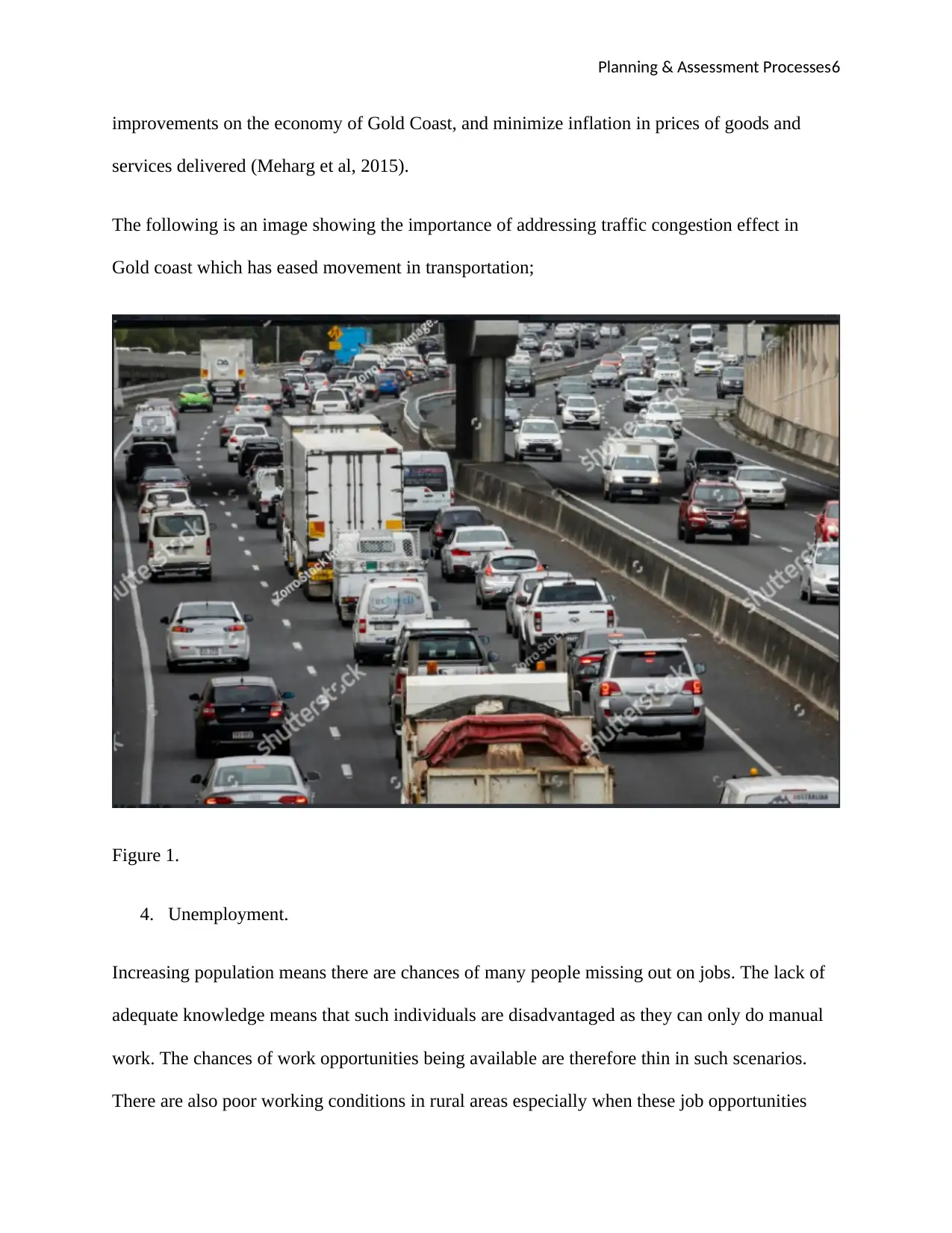
Planning & Assessment Processes6
improvements on the economy of Gold Coast, and minimize inflation in prices of goods and
services delivered (Meharg et al, 2015).
The following is an image showing the importance of addressing traffic congestion effect in
Gold coast which has eased movement in transportation;
Figure 1.
4. Unemployment.
Increasing population means there are chances of many people missing out on jobs. The lack of
adequate knowledge means that such individuals are disadvantaged as they can only do manual
work. The chances of work opportunities being available are therefore thin in such scenarios.
There are also poor working conditions in rural areas especially when these job opportunities
improvements on the economy of Gold Coast, and minimize inflation in prices of goods and
services delivered (Meharg et al, 2015).
The following is an image showing the importance of addressing traffic congestion effect in
Gold coast which has eased movement in transportation;
Figure 1.
4. Unemployment.
Increasing population means there are chances of many people missing out on jobs. The lack of
adequate knowledge means that such individuals are disadvantaged as they can only do manual
work. The chances of work opportunities being available are therefore thin in such scenarios.
There are also poor working conditions in rural areas especially when these job opportunities
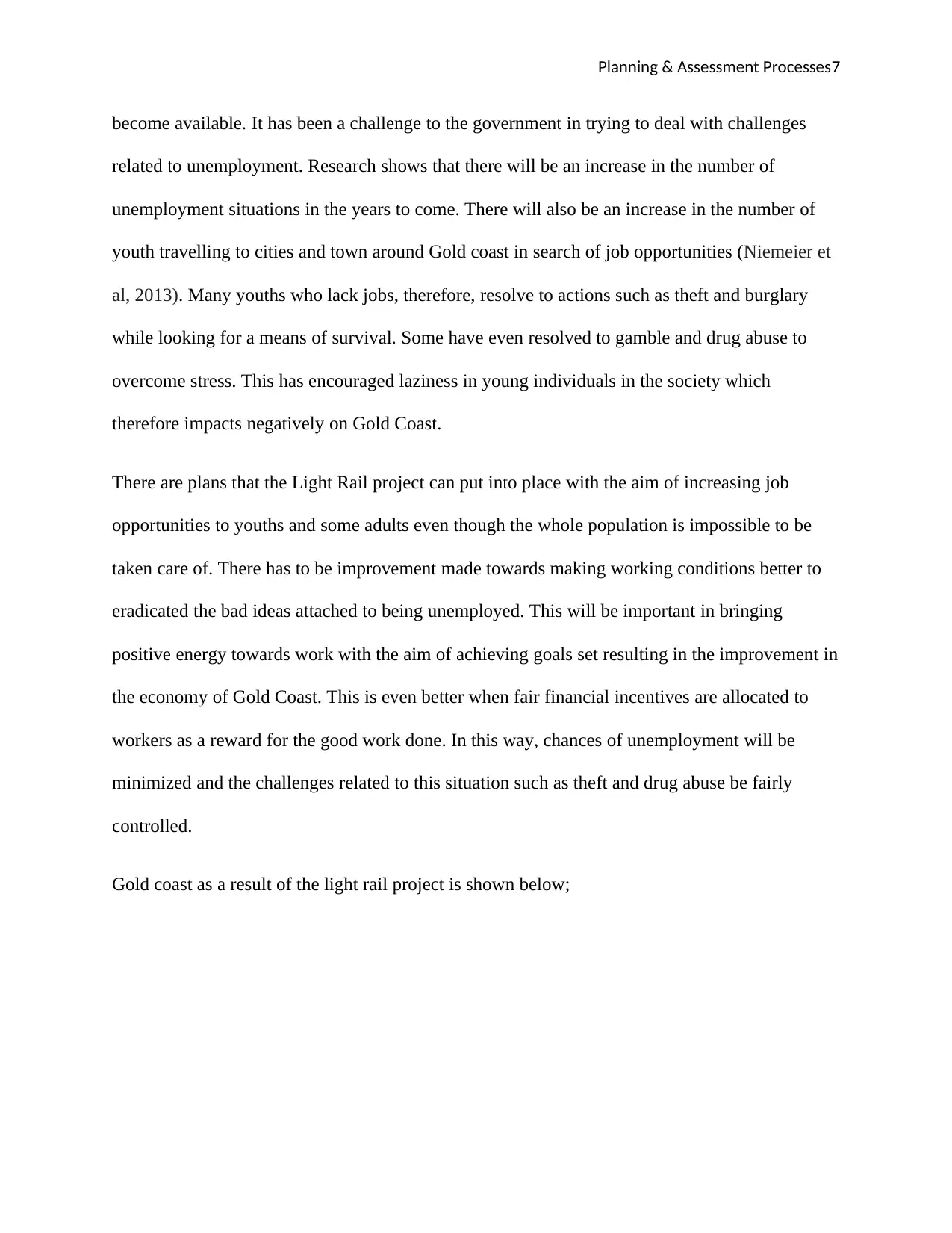
Planning & Assessment Processes7
become available. It has been a challenge to the government in trying to deal with challenges
related to unemployment. Research shows that there will be an increase in the number of
unemployment situations in the years to come. There will also be an increase in the number of
youth travelling to cities and town around Gold coast in search of job opportunities (Niemeier et
al, 2013). Many youths who lack jobs, therefore, resolve to actions such as theft and burglary
while looking for a means of survival. Some have even resolved to gamble and drug abuse to
overcome stress. This has encouraged laziness in young individuals in the society which
therefore impacts negatively on Gold Coast.
There are plans that the Light Rail project can put into place with the aim of increasing job
opportunities to youths and some adults even though the whole population is impossible to be
taken care of. There has to be improvement made towards making working conditions better to
eradicated the bad ideas attached to being unemployed. This will be important in bringing
positive energy towards work with the aim of achieving goals set resulting in the improvement in
the economy of Gold Coast. This is even better when fair financial incentives are allocated to
workers as a reward for the good work done. In this way, chances of unemployment will be
minimized and the challenges related to this situation such as theft and drug abuse be fairly
controlled.
Gold coast as a result of the light rail project is shown below;
become available. It has been a challenge to the government in trying to deal with challenges
related to unemployment. Research shows that there will be an increase in the number of
unemployment situations in the years to come. There will also be an increase in the number of
youth travelling to cities and town around Gold coast in search of job opportunities (Niemeier et
al, 2013). Many youths who lack jobs, therefore, resolve to actions such as theft and burglary
while looking for a means of survival. Some have even resolved to gamble and drug abuse to
overcome stress. This has encouraged laziness in young individuals in the society which
therefore impacts negatively on Gold Coast.
There are plans that the Light Rail project can put into place with the aim of increasing job
opportunities to youths and some adults even though the whole population is impossible to be
taken care of. There has to be improvement made towards making working conditions better to
eradicated the bad ideas attached to being unemployed. This will be important in bringing
positive energy towards work with the aim of achieving goals set resulting in the improvement in
the economy of Gold Coast. This is even better when fair financial incentives are allocated to
workers as a reward for the good work done. In this way, chances of unemployment will be
minimized and the challenges related to this situation such as theft and drug abuse be fairly
controlled.
Gold coast as a result of the light rail project is shown below;
Paraphrase This Document
Need a fresh take? Get an instant paraphrase of this document with our AI Paraphraser
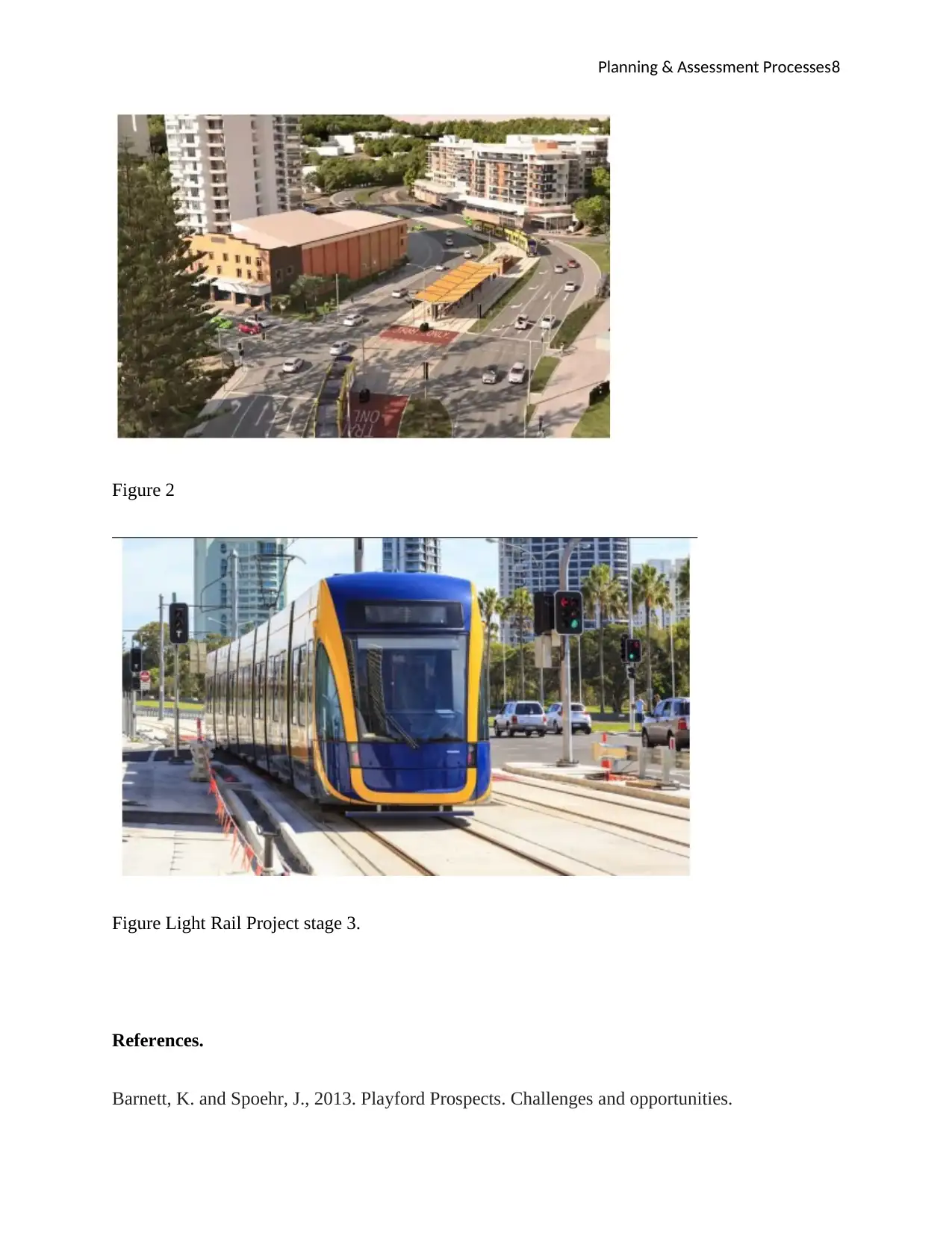
Planning & Assessment Processes8
Figure 2
Figure Light Rail Project stage 3.
References.
Barnett, K. and Spoehr, J., 2013. Playford Prospects. Challenges and opportunities.
Figure 2
Figure Light Rail Project stage 3.
References.
Barnett, K. and Spoehr, J., 2013. Playford Prospects. Challenges and opportunities.
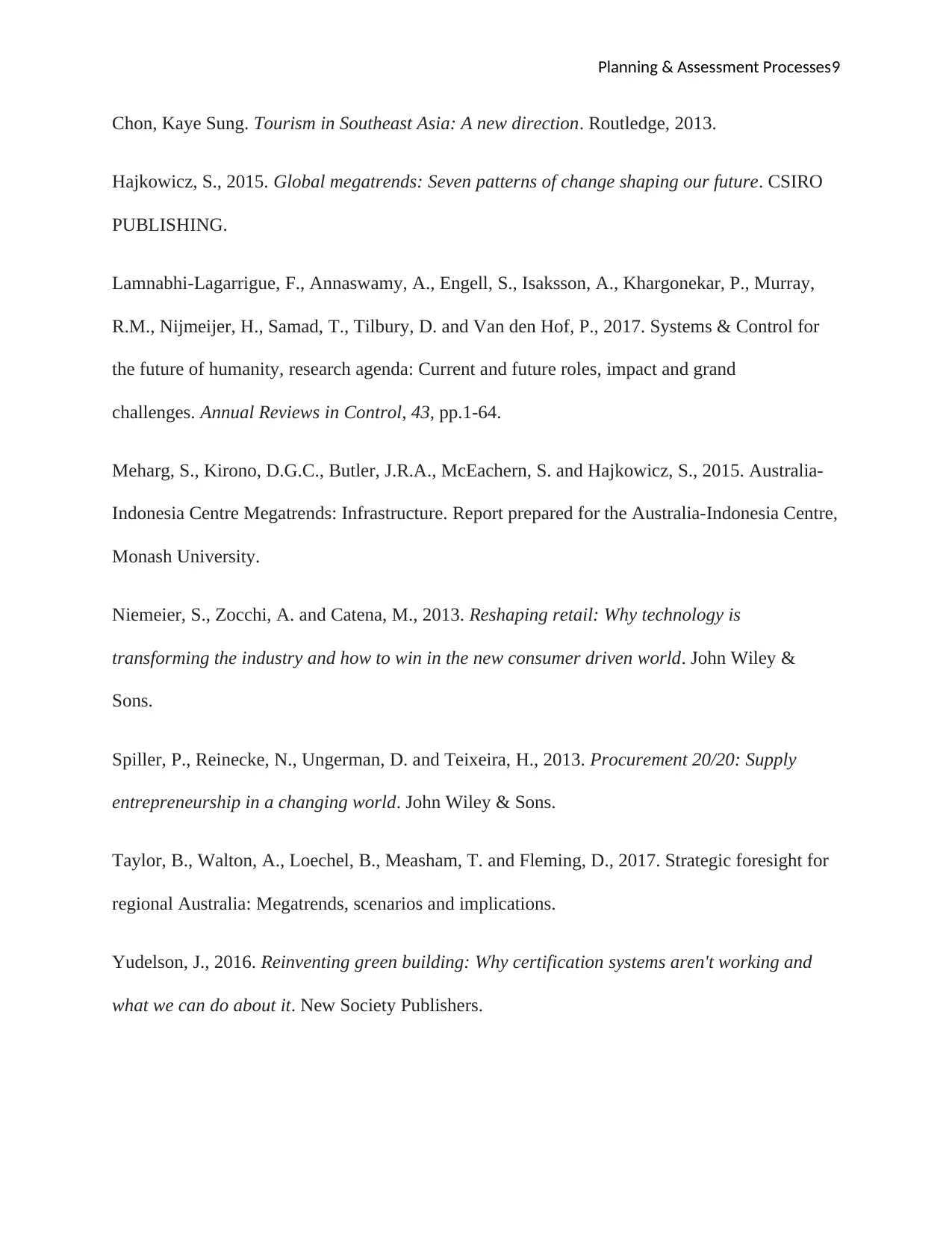
Planning & Assessment Processes9
Chon, Kaye Sung. Tourism in Southeast Asia: A new direction. Routledge, 2013.
Hajkowicz, S., 2015. Global megatrends: Seven patterns of change shaping our future. CSIRO
PUBLISHING.
Lamnabhi-Lagarrigue, F., Annaswamy, A., Engell, S., Isaksson, A., Khargonekar, P., Murray,
R.M., Nijmeijer, H., Samad, T., Tilbury, D. and Van den Hof, P., 2017. Systems & Control for
the future of humanity, research agenda: Current and future roles, impact and grand
challenges. Annual Reviews in Control, 43, pp.1-64.
Meharg, S., Kirono, D.G.C., Butler, J.R.A., McEachern, S. and Hajkowicz, S., 2015. Australia-
Indonesia Centre Megatrends: Infrastructure. Report prepared for the Australia-Indonesia Centre,
Monash University.
Niemeier, S., Zocchi, A. and Catena, M., 2013. Reshaping retail: Why technology is
transforming the industry and how to win in the new consumer driven world. John Wiley &
Sons.
Spiller, P., Reinecke, N., Ungerman, D. and Teixeira, H., 2013. Procurement 20/20: Supply
entrepreneurship in a changing world. John Wiley & Sons.
Taylor, B., Walton, A., Loechel, B., Measham, T. and Fleming, D., 2017. Strategic foresight for
regional Australia: Megatrends, scenarios and implications.
Yudelson, J., 2016. Reinventing green building: Why certification systems aren't working and
what we can do about it. New Society Publishers.
Chon, Kaye Sung. Tourism in Southeast Asia: A new direction. Routledge, 2013.
Hajkowicz, S., 2015. Global megatrends: Seven patterns of change shaping our future. CSIRO
PUBLISHING.
Lamnabhi-Lagarrigue, F., Annaswamy, A., Engell, S., Isaksson, A., Khargonekar, P., Murray,
R.M., Nijmeijer, H., Samad, T., Tilbury, D. and Van den Hof, P., 2017. Systems & Control for
the future of humanity, research agenda: Current and future roles, impact and grand
challenges. Annual Reviews in Control, 43, pp.1-64.
Meharg, S., Kirono, D.G.C., Butler, J.R.A., McEachern, S. and Hajkowicz, S., 2015. Australia-
Indonesia Centre Megatrends: Infrastructure. Report prepared for the Australia-Indonesia Centre,
Monash University.
Niemeier, S., Zocchi, A. and Catena, M., 2013. Reshaping retail: Why technology is
transforming the industry and how to win in the new consumer driven world. John Wiley &
Sons.
Spiller, P., Reinecke, N., Ungerman, D. and Teixeira, H., 2013. Procurement 20/20: Supply
entrepreneurship in a changing world. John Wiley & Sons.
Taylor, B., Walton, A., Loechel, B., Measham, T. and Fleming, D., 2017. Strategic foresight for
regional Australia: Megatrends, scenarios and implications.
Yudelson, J., 2016. Reinventing green building: Why certification systems aren't working and
what we can do about it. New Society Publishers.
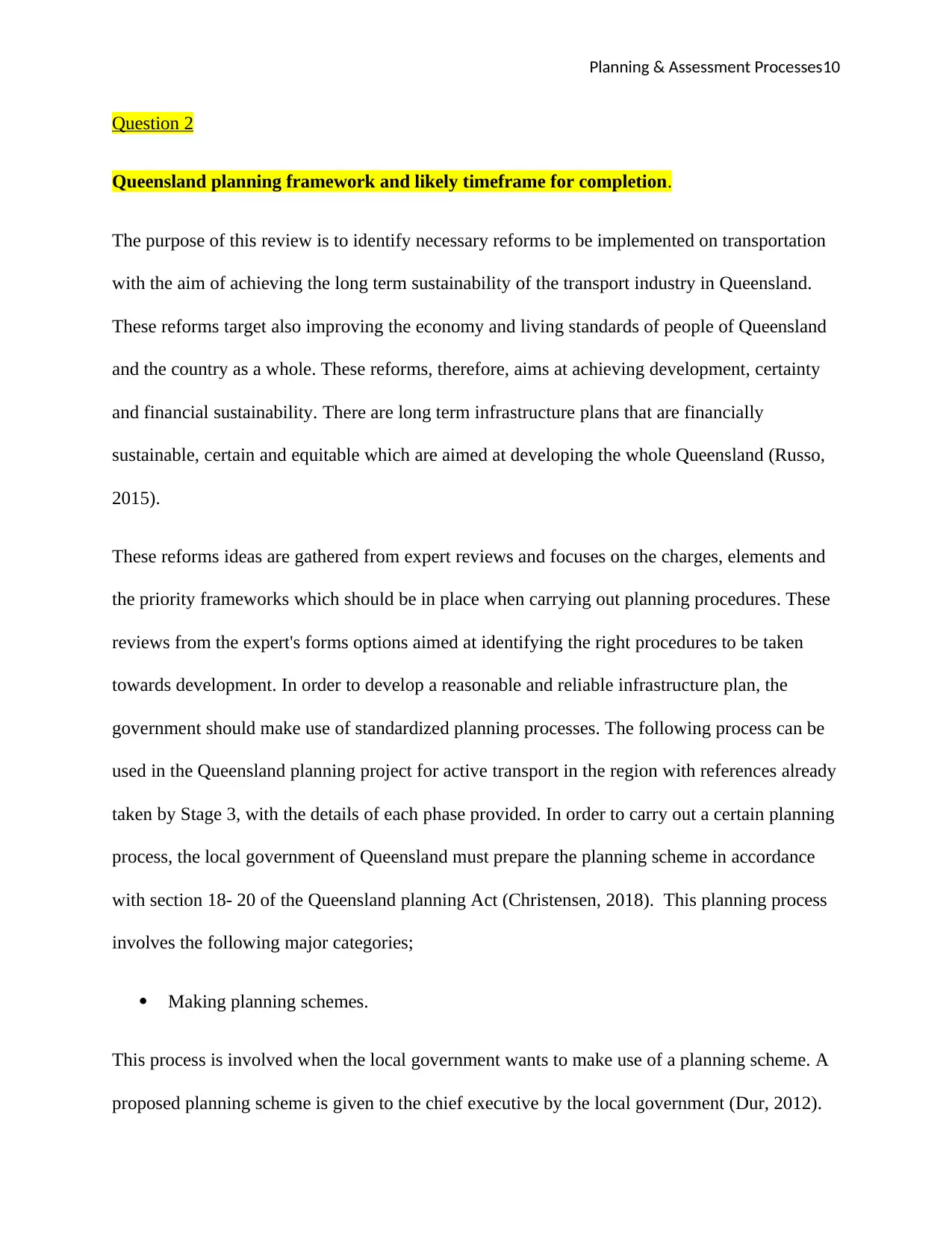
Planning & Assessment Processes10
Question 2
Queensland planning framework and likely timeframe for completion.
The purpose of this review is to identify necessary reforms to be implemented on transportation
with the aim of achieving the long term sustainability of the transport industry in Queensland.
These reforms target also improving the economy and living standards of people of Queensland
and the country as a whole. These reforms, therefore, aims at achieving development, certainty
and financial sustainability. There are long term infrastructure plans that are financially
sustainable, certain and equitable which are aimed at developing the whole Queensland (Russo,
2015).
These reforms ideas are gathered from expert reviews and focuses on the charges, elements and
the priority frameworks which should be in place when carrying out planning procedures. These
reviews from the expert's forms options aimed at identifying the right procedures to be taken
towards development. In order to develop a reasonable and reliable infrastructure plan, the
government should make use of standardized planning processes. The following process can be
used in the Queensland planning project for active transport in the region with references already
taken by Stage 3, with the details of each phase provided. In order to carry out a certain planning
process, the local government of Queensland must prepare the planning scheme in accordance
with section 18- 20 of the Queensland planning Act (Christensen, 2018). This planning process
involves the following major categories;
Making planning schemes.
This process is involved when the local government wants to make use of a planning scheme. A
proposed planning scheme is given to the chief executive by the local government (Dur, 2012).
Question 2
Queensland planning framework and likely timeframe for completion.
The purpose of this review is to identify necessary reforms to be implemented on transportation
with the aim of achieving the long term sustainability of the transport industry in Queensland.
These reforms target also improving the economy and living standards of people of Queensland
and the country as a whole. These reforms, therefore, aims at achieving development, certainty
and financial sustainability. There are long term infrastructure plans that are financially
sustainable, certain and equitable which are aimed at developing the whole Queensland (Russo,
2015).
These reforms ideas are gathered from expert reviews and focuses on the charges, elements and
the priority frameworks which should be in place when carrying out planning procedures. These
reviews from the expert's forms options aimed at identifying the right procedures to be taken
towards development. In order to develop a reasonable and reliable infrastructure plan, the
government should make use of standardized planning processes. The following process can be
used in the Queensland planning project for active transport in the region with references already
taken by Stage 3, with the details of each phase provided. In order to carry out a certain planning
process, the local government of Queensland must prepare the planning scheme in accordance
with section 18- 20 of the Queensland planning Act (Christensen, 2018). This planning process
involves the following major categories;
Making planning schemes.
This process is involved when the local government wants to make use of a planning scheme. A
proposed planning scheme is given to the chief executive by the local government (Dur, 2012).
Secure Best Marks with AI Grader
Need help grading? Try our AI Grader for instant feedback on your assignments.
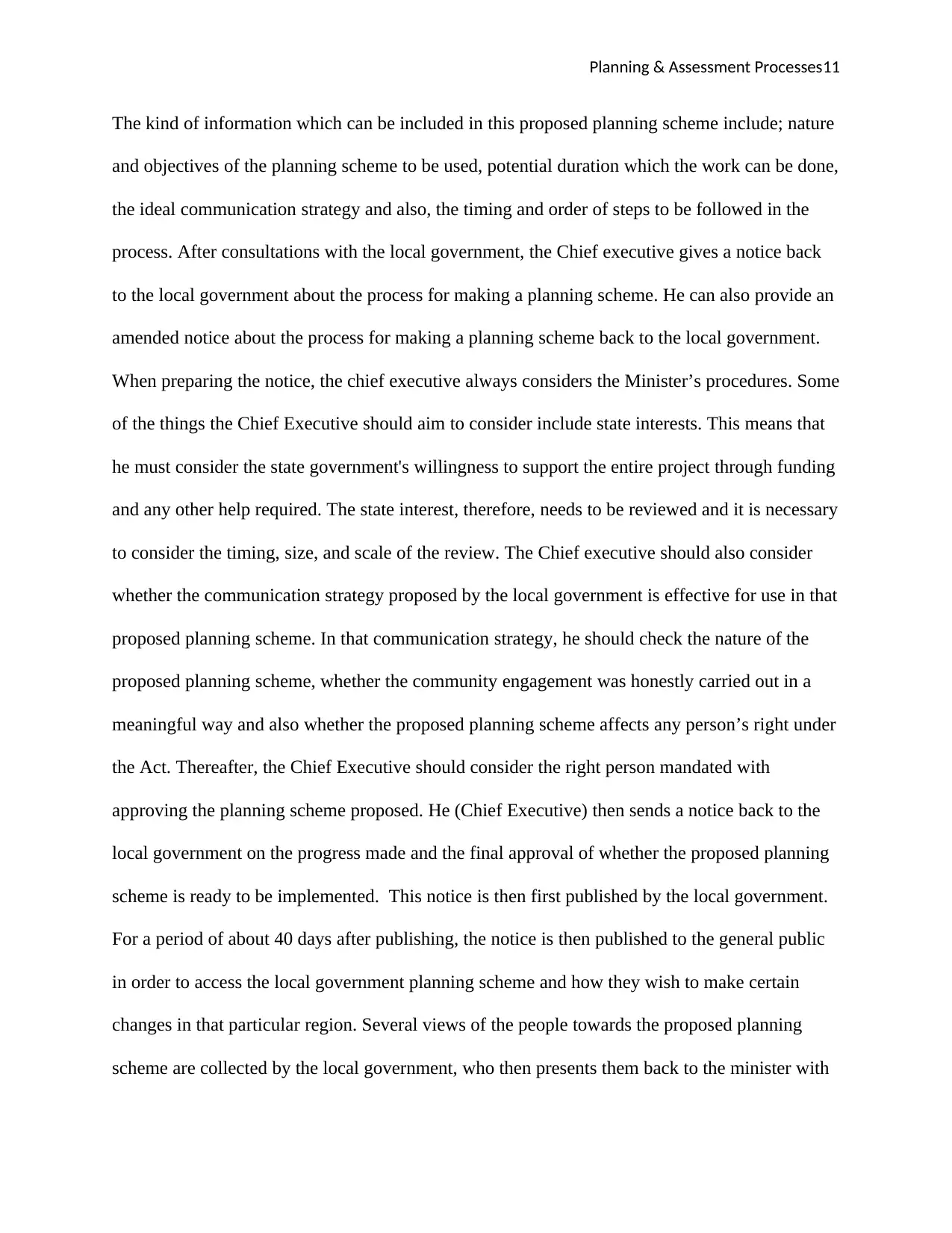
Planning & Assessment Processes11
The kind of information which can be included in this proposed planning scheme include; nature
and objectives of the planning scheme to be used, potential duration which the work can be done,
the ideal communication strategy and also, the timing and order of steps to be followed in the
process. After consultations with the local government, the Chief executive gives a notice back
to the local government about the process for making a planning scheme. He can also provide an
amended notice about the process for making a planning scheme back to the local government.
When preparing the notice, the chief executive always considers the Minister’s procedures. Some
of the things the Chief Executive should aim to consider include state interests. This means that
he must consider the state government's willingness to support the entire project through funding
and any other help required. The state interest, therefore, needs to be reviewed and it is necessary
to consider the timing, size, and scale of the review. The Chief executive should also consider
whether the communication strategy proposed by the local government is effective for use in that
proposed planning scheme. In that communication strategy, he should check the nature of the
proposed planning scheme, whether the community engagement was honestly carried out in a
meaningful way and also whether the proposed planning scheme affects any person’s right under
the Act. Thereafter, the Chief Executive should consider the right person mandated with
approving the planning scheme proposed. He (Chief Executive) then sends a notice back to the
local government on the progress made and the final approval of whether the proposed planning
scheme is ready to be implemented. This notice is then first published by the local government.
For a period of about 40 days after publishing, the notice is then published to the general public
in order to access the local government planning scheme and how they wish to make certain
changes in that particular region. Several views of the people towards the proposed planning
scheme are collected by the local government, who then presents them back to the minister with
The kind of information which can be included in this proposed planning scheme include; nature
and objectives of the planning scheme to be used, potential duration which the work can be done,
the ideal communication strategy and also, the timing and order of steps to be followed in the
process. After consultations with the local government, the Chief executive gives a notice back
to the local government about the process for making a planning scheme. He can also provide an
amended notice about the process for making a planning scheme back to the local government.
When preparing the notice, the chief executive always considers the Minister’s procedures. Some
of the things the Chief Executive should aim to consider include state interests. This means that
he must consider the state government's willingness to support the entire project through funding
and any other help required. The state interest, therefore, needs to be reviewed and it is necessary
to consider the timing, size, and scale of the review. The Chief executive should also consider
whether the communication strategy proposed by the local government is effective for use in that
proposed planning scheme. In that communication strategy, he should check the nature of the
proposed planning scheme, whether the community engagement was honestly carried out in a
meaningful way and also whether the proposed planning scheme affects any person’s right under
the Act. Thereafter, the Chief Executive should consider the right person mandated with
approving the planning scheme proposed. He (Chief Executive) then sends a notice back to the
local government on the progress made and the final approval of whether the proposed planning
scheme is ready to be implemented. This notice is then first published by the local government.
For a period of about 40 days after publishing, the notice is then published to the general public
in order to access the local government planning scheme and how they wish to make certain
changes in that particular region. Several views of the people towards the proposed planning
scheme are collected by the local government, who then presents them back to the minister with
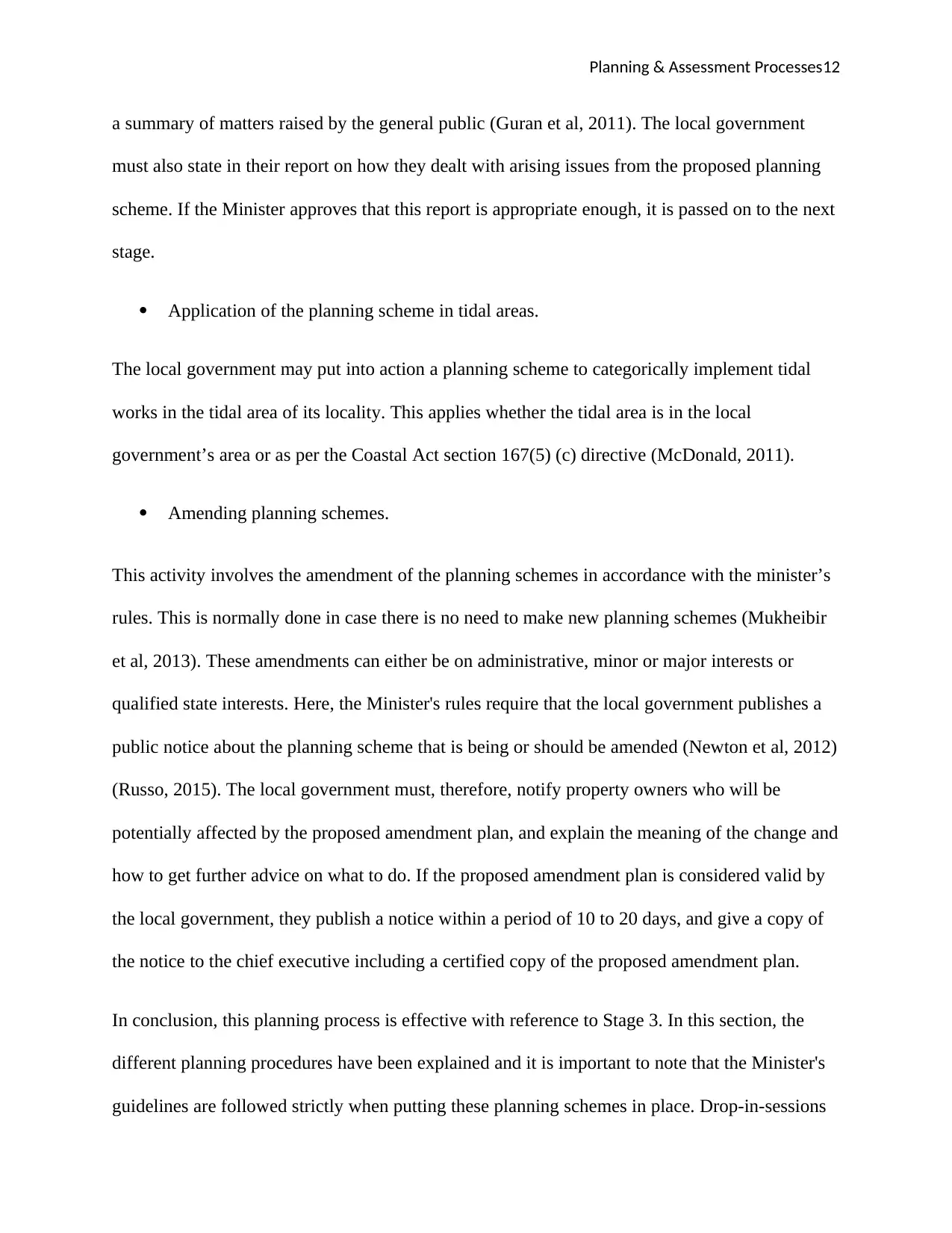
Planning & Assessment Processes12
a summary of matters raised by the general public (Guran et al, 2011). The local government
must also state in their report on how they dealt with arising issues from the proposed planning
scheme. If the Minister approves that this report is appropriate enough, it is passed on to the next
stage.
Application of the planning scheme in tidal areas.
The local government may put into action a planning scheme to categorically implement tidal
works in the tidal area of its locality. This applies whether the tidal area is in the local
government’s area or as per the Coastal Act section 167(5) (c) directive (McDonald, 2011).
Amending planning schemes.
This activity involves the amendment of the planning schemes in accordance with the minister’s
rules. This is normally done in case there is no need to make new planning schemes (Mukheibir
et al, 2013). These amendments can either be on administrative, minor or major interests or
qualified state interests. Here, the Minister's rules require that the local government publishes a
public notice about the planning scheme that is being or should be amended (Newton et al, 2012)
(Russo, 2015). The local government must, therefore, notify property owners who will be
potentially affected by the proposed amendment plan, and explain the meaning of the change and
how to get further advice on what to do. If the proposed amendment plan is considered valid by
the local government, they publish a notice within a period of 10 to 20 days, and give a copy of
the notice to the chief executive including a certified copy of the proposed amendment plan.
In conclusion, this planning process is effective with reference to Stage 3. In this section, the
different planning procedures have been explained and it is important to note that the Minister's
guidelines are followed strictly when putting these planning schemes in place. Drop-in-sessions
a summary of matters raised by the general public (Guran et al, 2011). The local government
must also state in their report on how they dealt with arising issues from the proposed planning
scheme. If the Minister approves that this report is appropriate enough, it is passed on to the next
stage.
Application of the planning scheme in tidal areas.
The local government may put into action a planning scheme to categorically implement tidal
works in the tidal area of its locality. This applies whether the tidal area is in the local
government’s area or as per the Coastal Act section 167(5) (c) directive (McDonald, 2011).
Amending planning schemes.
This activity involves the amendment of the planning schemes in accordance with the minister’s
rules. This is normally done in case there is no need to make new planning schemes (Mukheibir
et al, 2013). These amendments can either be on administrative, minor or major interests or
qualified state interests. Here, the Minister's rules require that the local government publishes a
public notice about the planning scheme that is being or should be amended (Newton et al, 2012)
(Russo, 2015). The local government must, therefore, notify property owners who will be
potentially affected by the proposed amendment plan, and explain the meaning of the change and
how to get further advice on what to do. If the proposed amendment plan is considered valid by
the local government, they publish a notice within a period of 10 to 20 days, and give a copy of
the notice to the chief executive including a certified copy of the proposed amendment plan.
In conclusion, this planning process is effective with reference to Stage 3. In this section, the
different planning procedures have been explained and it is important to note that the Minister's
guidelines are followed strictly when putting these planning schemes in place. Drop-in-sessions
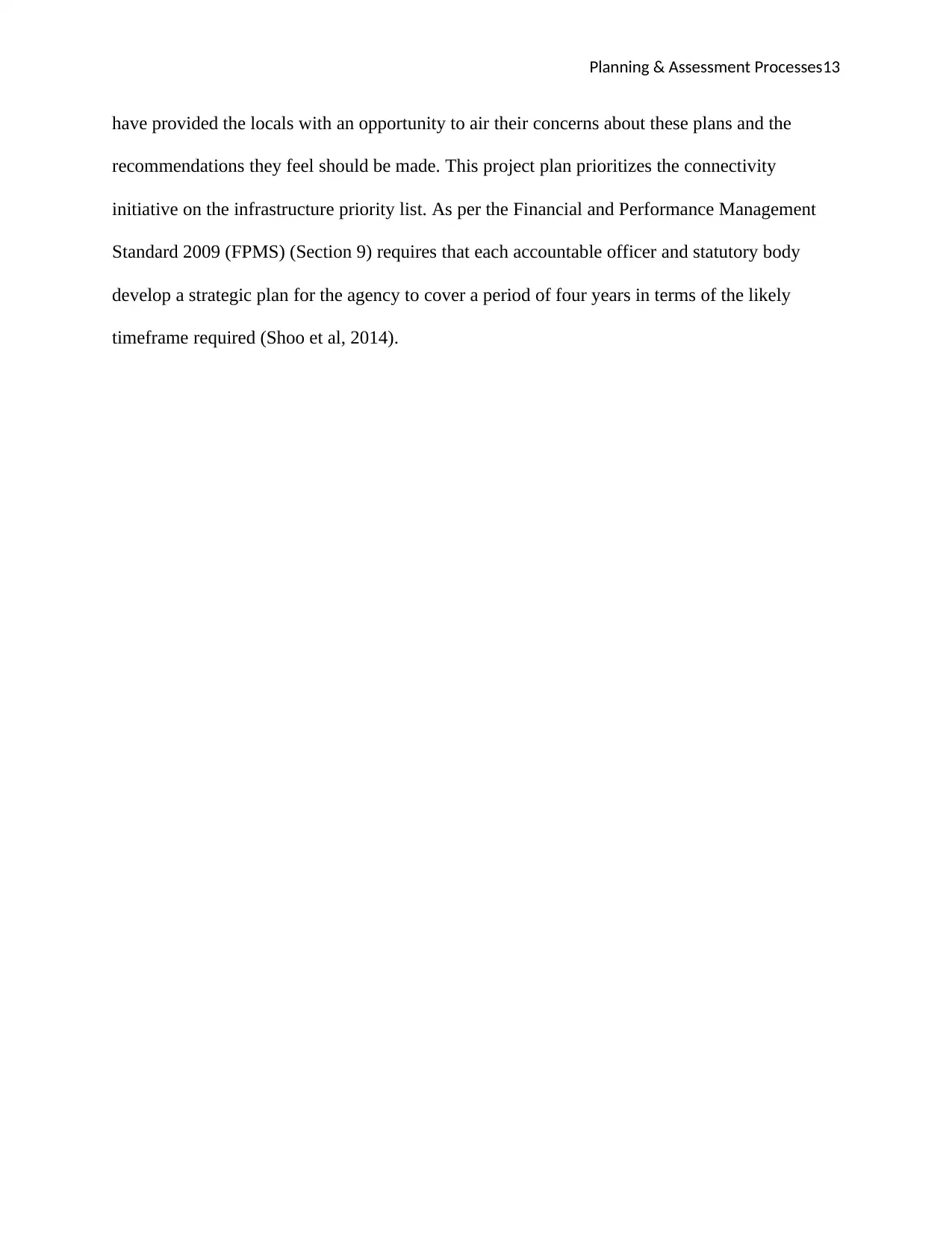
Planning & Assessment Processes13
have provided the locals with an opportunity to air their concerns about these plans and the
recommendations they feel should be made. This project plan prioritizes the connectivity
initiative on the infrastructure priority list. As per the Financial and Performance Management
Standard 2009 (FPMS) (Section 9) requires that each accountable officer and statutory body
develop a strategic plan for the agency to cover a period of four years in terms of the likely
timeframe required (Shoo et al, 2014).
have provided the locals with an opportunity to air their concerns about these plans and the
recommendations they feel should be made. This project plan prioritizes the connectivity
initiative on the infrastructure priority list. As per the Financial and Performance Management
Standard 2009 (FPMS) (Section 9) requires that each accountable officer and statutory body
develop a strategic plan for the agency to cover a period of four years in terms of the likely
timeframe required (Shoo et al, 2014).
Paraphrase This Document
Need a fresh take? Get an instant paraphrase of this document with our AI Paraphraser
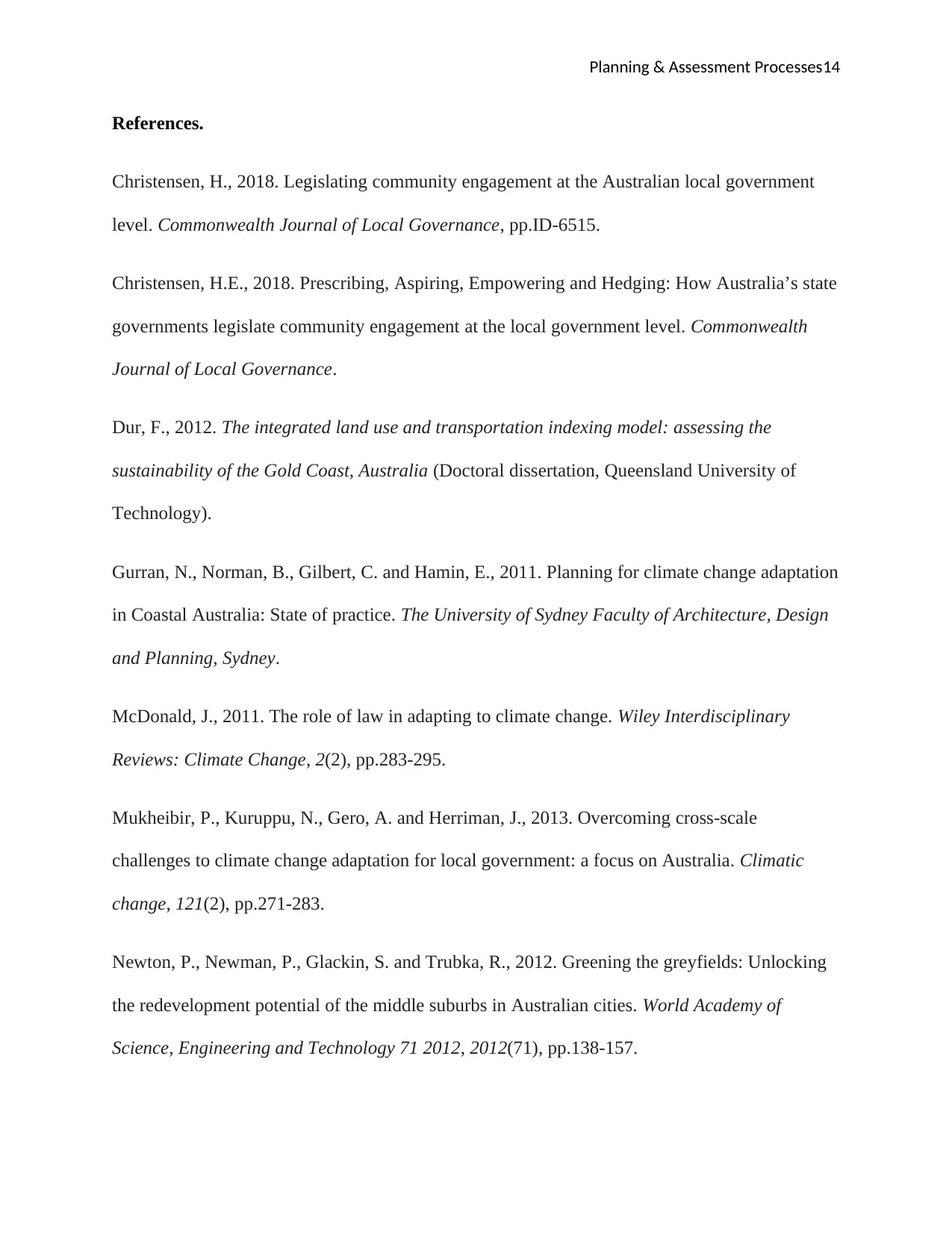
Planning & Assessment Processes14
References.
Christensen, H., 2018. Legislating community engagement at the Australian local government
level. Commonwealth Journal of Local Governance, pp.ID-6515.
Christensen, H.E., 2018. Prescribing, Aspiring, Empowering and Hedging: How Australia’s state
governments legislate community engagement at the local government level. Commonwealth
Journal of Local Governance.
Dur, F., 2012. The integrated land use and transportation indexing model: assessing the
sustainability of the Gold Coast, Australia (Doctoral dissertation, Queensland University of
Technology).
Gurran, N., Norman, B., Gilbert, C. and Hamin, E., 2011. Planning for climate change adaptation
in Coastal Australia: State of practice. The University of Sydney Faculty of Architecture, Design
and Planning, Sydney.
McDonald, J., 2011. The role of law in adapting to climate change. Wiley Interdisciplinary
Reviews: Climate Change, 2(2), pp.283-295.
Mukheibir, P., Kuruppu, N., Gero, A. and Herriman, J., 2013. Overcoming cross-scale
challenges to climate change adaptation for local government: a focus on Australia. Climatic
change, 121(2), pp.271-283.
Newton, P., Newman, P., Glackin, S. and Trubka, R., 2012. Greening the greyfields: Unlocking
the redevelopment potential of the middle suburbs in Australian cities. World Academy of
Science, Engineering and Technology 71 2012, 2012(71), pp.138-157.
References.
Christensen, H., 2018. Legislating community engagement at the Australian local government
level. Commonwealth Journal of Local Governance, pp.ID-6515.
Christensen, H.E., 2018. Prescribing, Aspiring, Empowering and Hedging: How Australia’s state
governments legislate community engagement at the local government level. Commonwealth
Journal of Local Governance.
Dur, F., 2012. The integrated land use and transportation indexing model: assessing the
sustainability of the Gold Coast, Australia (Doctoral dissertation, Queensland University of
Technology).
Gurran, N., Norman, B., Gilbert, C. and Hamin, E., 2011. Planning for climate change adaptation
in Coastal Australia: State of practice. The University of Sydney Faculty of Architecture, Design
and Planning, Sydney.
McDonald, J., 2011. The role of law in adapting to climate change. Wiley Interdisciplinary
Reviews: Climate Change, 2(2), pp.283-295.
Mukheibir, P., Kuruppu, N., Gero, A. and Herriman, J., 2013. Overcoming cross-scale
challenges to climate change adaptation for local government: a focus on Australia. Climatic
change, 121(2), pp.271-283.
Newton, P., Newman, P., Glackin, S. and Trubka, R., 2012. Greening the greyfields: Unlocking
the redevelopment potential of the middle suburbs in Australian cities. World Academy of
Science, Engineering and Technology 71 2012, 2012(71), pp.138-157.
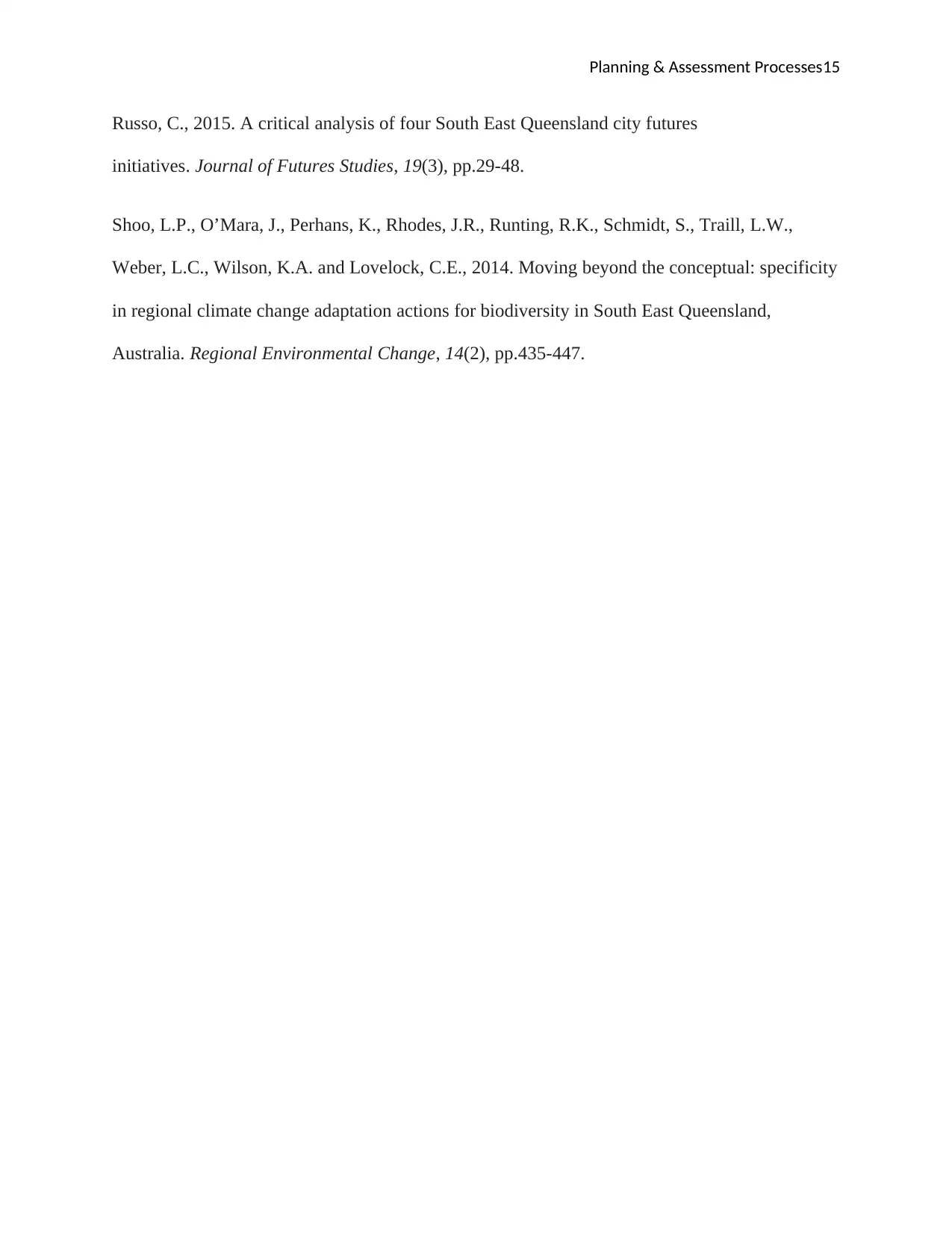
Planning & Assessment Processes15
Russo, C., 2015. A critical analysis of four South East Queensland city futures
initiatives. Journal of Futures Studies, 19(3), pp.29-48.
Shoo, L.P., O’Mara, J., Perhans, K., Rhodes, J.R., Runting, R.K., Schmidt, S., Traill, L.W.,
Weber, L.C., Wilson, K.A. and Lovelock, C.E., 2014. Moving beyond the conceptual: specificity
in regional climate change adaptation actions for biodiversity in South East Queensland,
Australia. Regional Environmental Change, 14(2), pp.435-447.
Russo, C., 2015. A critical analysis of four South East Queensland city futures
initiatives. Journal of Futures Studies, 19(3), pp.29-48.
Shoo, L.P., O’Mara, J., Perhans, K., Rhodes, J.R., Runting, R.K., Schmidt, S., Traill, L.W.,
Weber, L.C., Wilson, K.A. and Lovelock, C.E., 2014. Moving beyond the conceptual: specificity
in regional climate change adaptation actions for biodiversity in South East Queensland,
Australia. Regional Environmental Change, 14(2), pp.435-447.
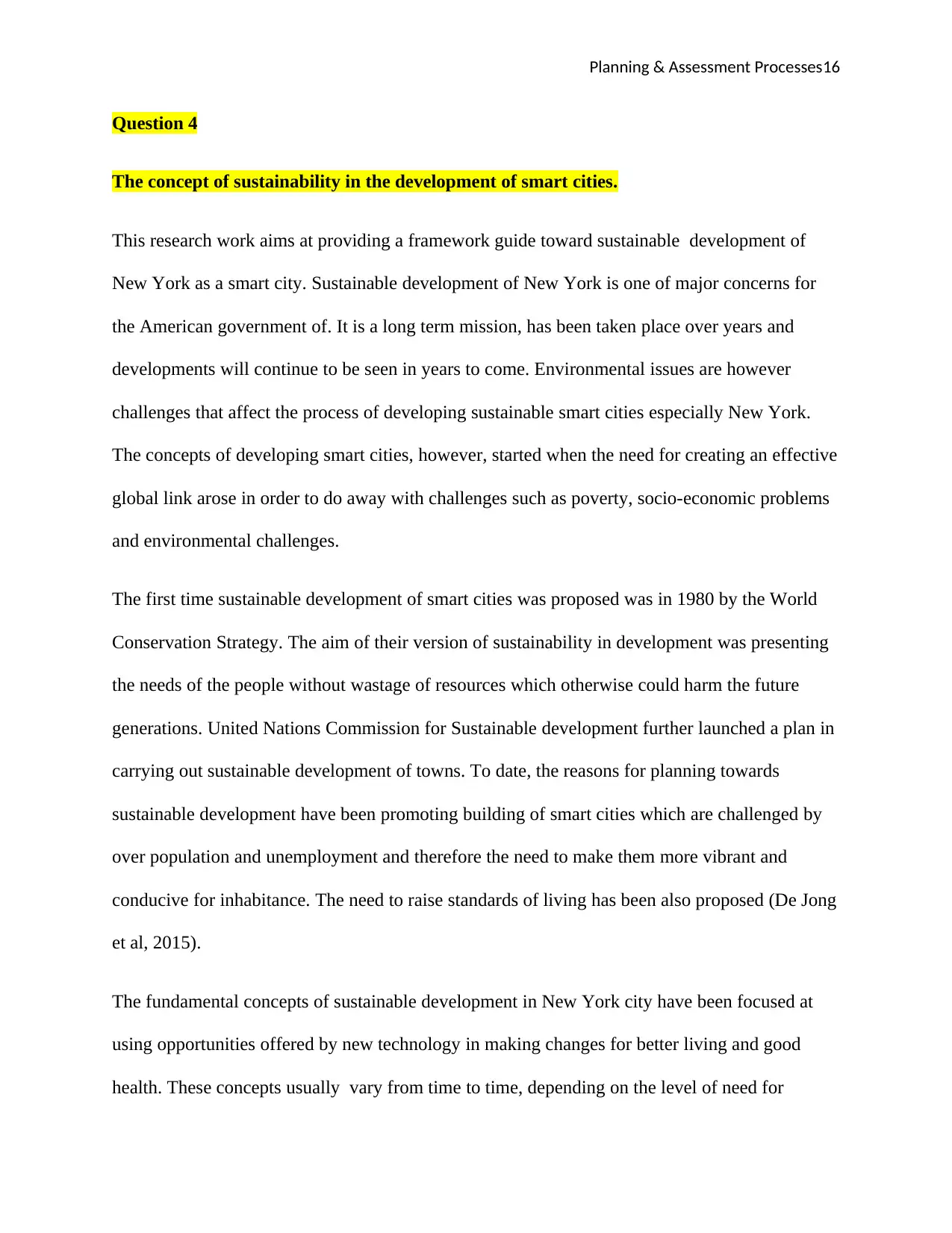
Planning & Assessment Processes16
Question 4
The concept of sustainability in the development of smart cities.
This research work aims at providing a framework guide toward sustainable development of
New York as a smart city. Sustainable development of New York is one of major concerns for
the American government of. It is a long term mission, has been taken place over years and
developments will continue to be seen in years to come. Environmental issues are however
challenges that affect the process of developing sustainable smart cities especially New York.
The concepts of developing smart cities, however, started when the need for creating an effective
global link arose in order to do away with challenges such as poverty, socio-economic problems
and environmental challenges.
The first time sustainable development of smart cities was proposed was in 1980 by the World
Conservation Strategy. The aim of their version of sustainability in development was presenting
the needs of the people without wastage of resources which otherwise could harm the future
generations. United Nations Commission for Sustainable development further launched a plan in
carrying out sustainable development of towns. To date, the reasons for planning towards
sustainable development have been promoting building of smart cities which are challenged by
over population and unemployment and therefore the need to make them more vibrant and
conducive for inhabitance. The need to raise standards of living has been also proposed (De Jong
et al, 2015).
The fundamental concepts of sustainable development in New York city have been focused at
using opportunities offered by new technology in making changes for better living and good
health. These concepts usually vary from time to time, depending on the level of need for
Question 4
The concept of sustainability in the development of smart cities.
This research work aims at providing a framework guide toward sustainable development of
New York as a smart city. Sustainable development of New York is one of major concerns for
the American government of. It is a long term mission, has been taken place over years and
developments will continue to be seen in years to come. Environmental issues are however
challenges that affect the process of developing sustainable smart cities especially New York.
The concepts of developing smart cities, however, started when the need for creating an effective
global link arose in order to do away with challenges such as poverty, socio-economic problems
and environmental challenges.
The first time sustainable development of smart cities was proposed was in 1980 by the World
Conservation Strategy. The aim of their version of sustainability in development was presenting
the needs of the people without wastage of resources which otherwise could harm the future
generations. United Nations Commission for Sustainable development further launched a plan in
carrying out sustainable development of towns. To date, the reasons for planning towards
sustainable development have been promoting building of smart cities which are challenged by
over population and unemployment and therefore the need to make them more vibrant and
conducive for inhabitance. The need to raise standards of living has been also proposed (De Jong
et al, 2015).
The fundamental concepts of sustainable development in New York city have been focused at
using opportunities offered by new technology in making changes for better living and good
health. These concepts usually vary from time to time, depending on the level of need for
Secure Best Marks with AI Grader
Need help grading? Try our AI Grader for instant feedback on your assignments.
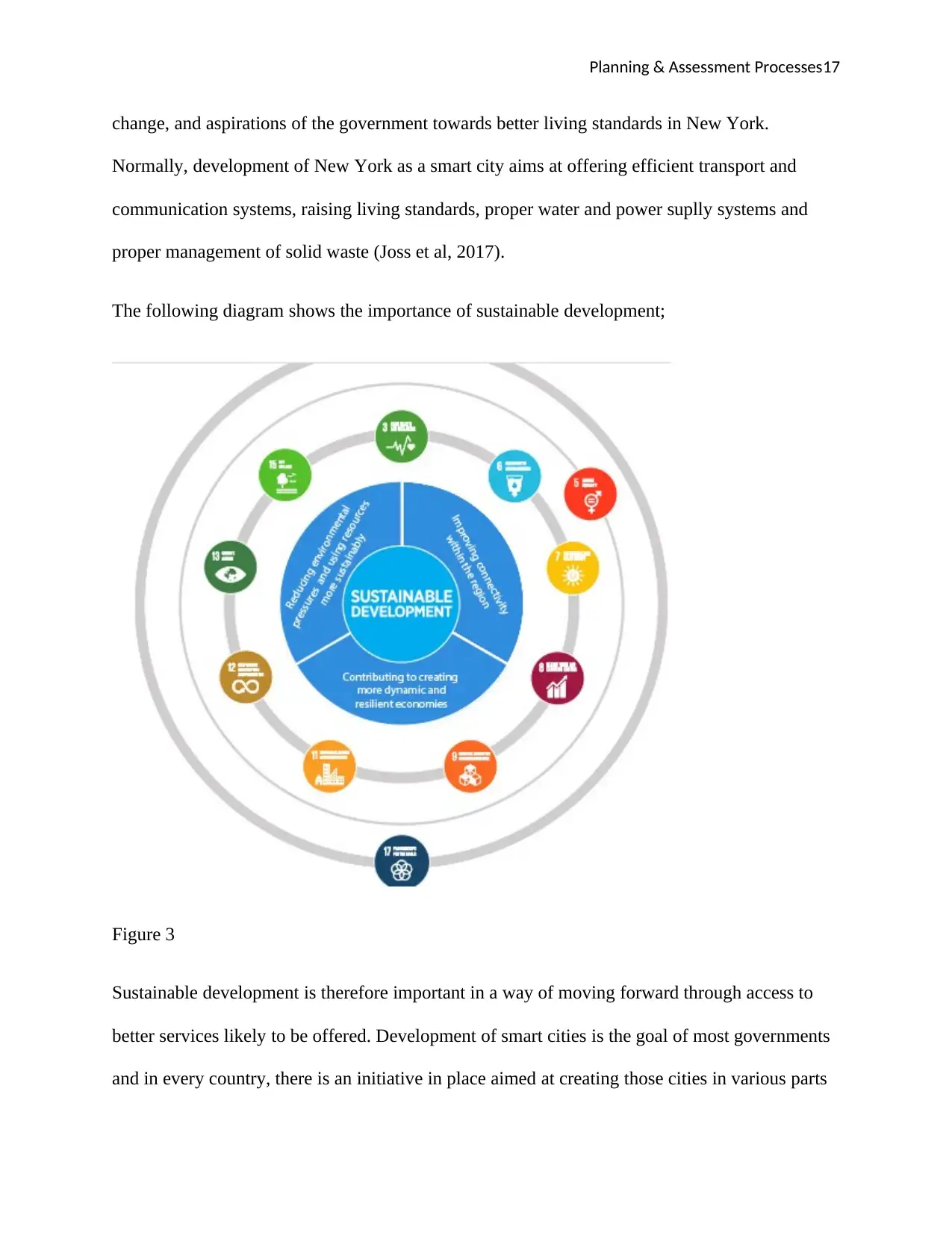
Planning & Assessment Processes17
change, and aspirations of the government towards better living standards in New York.
Normally, development of New York as a smart city aims at offering efficient transport and
communication systems, raising living standards, proper water and power suplly systems and
proper management of solid waste (Joss et al, 2017).
The following diagram shows the importance of sustainable development;
Figure 3
Sustainable development is therefore important in a way of moving forward through access to
better services likely to be offered. Development of smart cities is the goal of most governments
and in every country, there is an initiative in place aimed at creating those cities in various parts
change, and aspirations of the government towards better living standards in New York.
Normally, development of New York as a smart city aims at offering efficient transport and
communication systems, raising living standards, proper water and power suplly systems and
proper management of solid waste (Joss et al, 2017).
The following diagram shows the importance of sustainable development;
Figure 3
Sustainable development is therefore important in a way of moving forward through access to
better services likely to be offered. Development of smart cities is the goal of most governments
and in every country, there is an initiative in place aimed at creating those cities in various parts
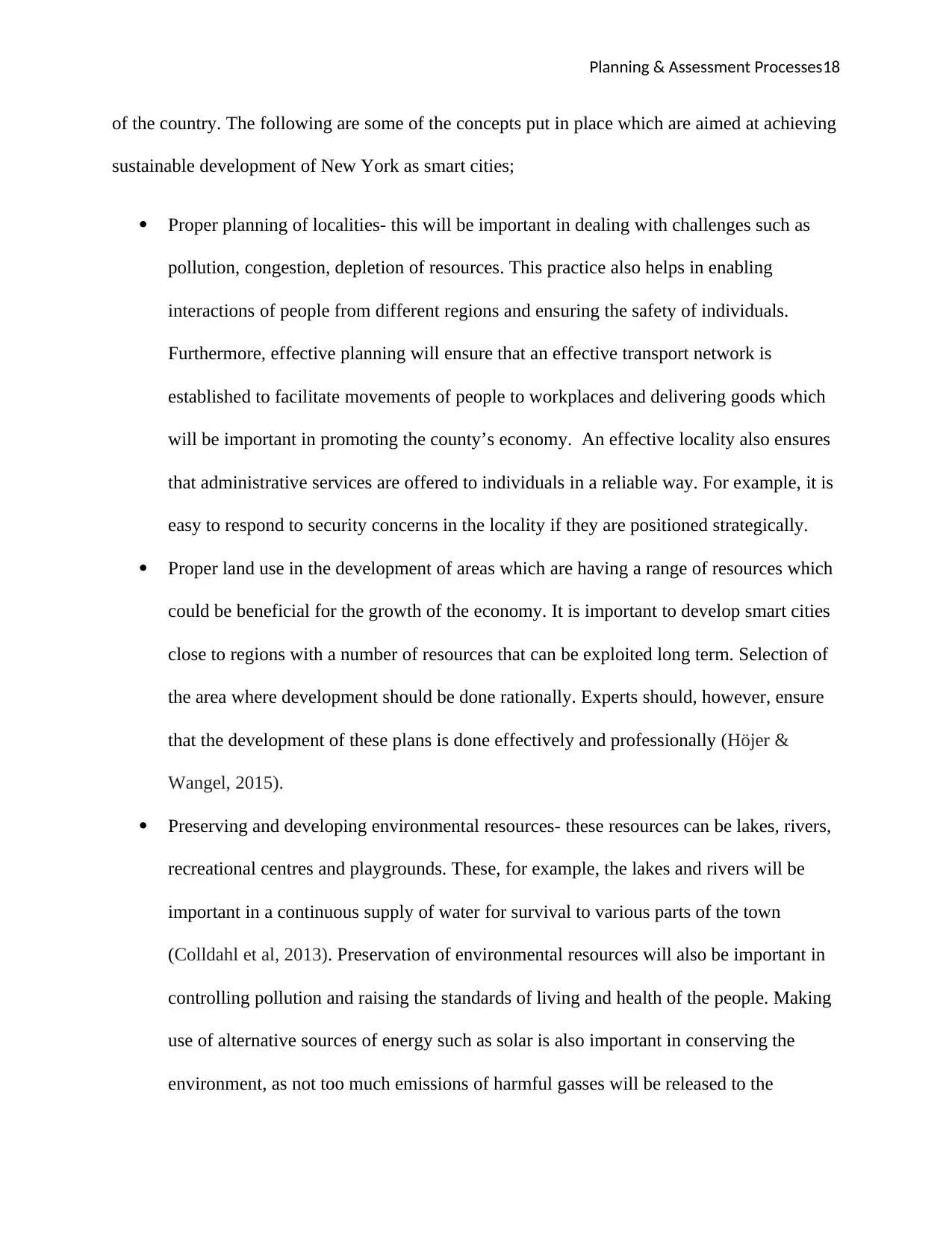
Planning & Assessment Processes18
of the country. The following are some of the concepts put in place which are aimed at achieving
sustainable development of New York as smart cities;
Proper planning of localities- this will be important in dealing with challenges such as
pollution, congestion, depletion of resources. This practice also helps in enabling
interactions of people from different regions and ensuring the safety of individuals.
Furthermore, effective planning will ensure that an effective transport network is
established to facilitate movements of people to workplaces and delivering goods which
will be important in promoting the county’s economy. An effective locality also ensures
that administrative services are offered to individuals in a reliable way. For example, it is
easy to respond to security concerns in the locality if they are positioned strategically.
Proper land use in the development of areas which are having a range of resources which
could be beneficial for the growth of the economy. It is important to develop smart cities
close to regions with a number of resources that can be exploited long term. Selection of
the area where development should be done rationally. Experts should, however, ensure
that the development of these plans is done effectively and professionally (Höjer &
Wangel, 2015).
Preserving and developing environmental resources- these resources can be lakes, rivers,
recreational centres and playgrounds. These, for example, the lakes and rivers will be
important in a continuous supply of water for survival to various parts of the town
(Colldahl et al, 2013). Preservation of environmental resources will also be important in
controlling pollution and raising the standards of living and health of the people. Making
use of alternative sources of energy such as solar is also important in conserving the
environment, as not too much emissions of harmful gasses will be released to the
of the country. The following are some of the concepts put in place which are aimed at achieving
sustainable development of New York as smart cities;
Proper planning of localities- this will be important in dealing with challenges such as
pollution, congestion, depletion of resources. This practice also helps in enabling
interactions of people from different regions and ensuring the safety of individuals.
Furthermore, effective planning will ensure that an effective transport network is
established to facilitate movements of people to workplaces and delivering goods which
will be important in promoting the county’s economy. An effective locality also ensures
that administrative services are offered to individuals in a reliable way. For example, it is
easy to respond to security concerns in the locality if they are positioned strategically.
Proper land use in the development of areas which are having a range of resources which
could be beneficial for the growth of the economy. It is important to develop smart cities
close to regions with a number of resources that can be exploited long term. Selection of
the area where development should be done rationally. Experts should, however, ensure
that the development of these plans is done effectively and professionally (Höjer &
Wangel, 2015).
Preserving and developing environmental resources- these resources can be lakes, rivers,
recreational centres and playgrounds. These, for example, the lakes and rivers will be
important in a continuous supply of water for survival to various parts of the town
(Colldahl et al, 2013). Preservation of environmental resources will also be important in
controlling pollution and raising the standards of living and health of the people. Making
use of alternative sources of energy such as solar is also important in conserving the
environment, as not too much emissions of harmful gasses will be released to the
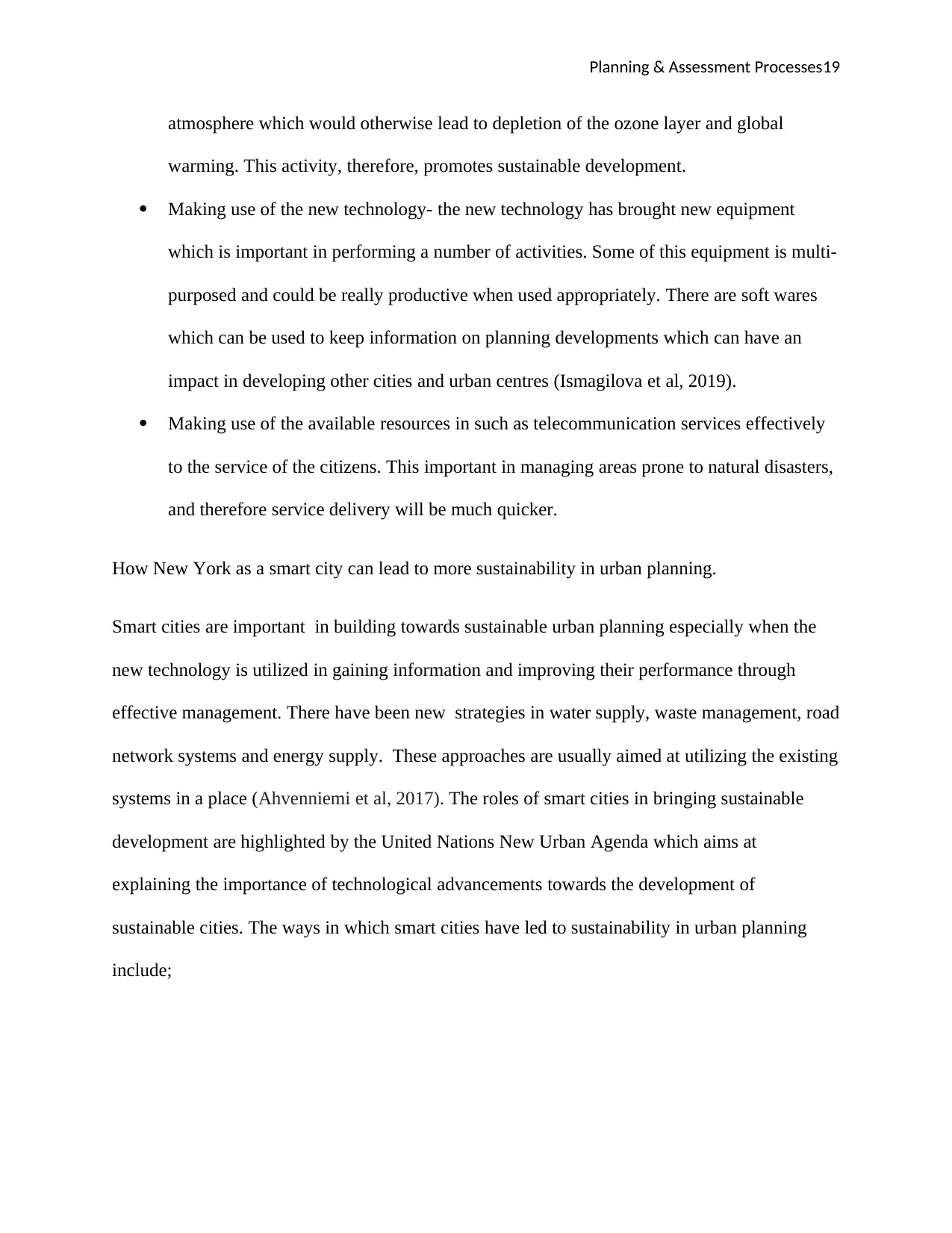
Planning & Assessment Processes19
atmosphere which would otherwise lead to depletion of the ozone layer and global
warming. This activity, therefore, promotes sustainable development.
Making use of the new technology- the new technology has brought new equipment
which is important in performing a number of activities. Some of this equipment is multi-
purposed and could be really productive when used appropriately. There are soft wares
which can be used to keep information on planning developments which can have an
impact in developing other cities and urban centres (Ismagilova et al, 2019).
Making use of the available resources in such as telecommunication services effectively
to the service of the citizens. This important in managing areas prone to natural disasters,
and therefore service delivery will be much quicker.
How New York as a smart city can lead to more sustainability in urban planning.
Smart cities are important in building towards sustainable urban planning especially when the
new technology is utilized in gaining information and improving their performance through
effective management. There have been new strategies in water supply, waste management, road
network systems and energy supply. These approaches are usually aimed at utilizing the existing
systems in a place (Ahvenniemi et al, 2017). The roles of smart cities in bringing sustainable
development are highlighted by the United Nations New Urban Agenda which aims at
explaining the importance of technological advancements towards the development of
sustainable cities. The ways in which smart cities have led to sustainability in urban planning
include;
atmosphere which would otherwise lead to depletion of the ozone layer and global
warming. This activity, therefore, promotes sustainable development.
Making use of the new technology- the new technology has brought new equipment
which is important in performing a number of activities. Some of this equipment is multi-
purposed and could be really productive when used appropriately. There are soft wares
which can be used to keep information on planning developments which can have an
impact in developing other cities and urban centres (Ismagilova et al, 2019).
Making use of the available resources in such as telecommunication services effectively
to the service of the citizens. This important in managing areas prone to natural disasters,
and therefore service delivery will be much quicker.
How New York as a smart city can lead to more sustainability in urban planning.
Smart cities are important in building towards sustainable urban planning especially when the
new technology is utilized in gaining information and improving their performance through
effective management. There have been new strategies in water supply, waste management, road
network systems and energy supply. These approaches are usually aimed at utilizing the existing
systems in a place (Ahvenniemi et al, 2017). The roles of smart cities in bringing sustainable
development are highlighted by the United Nations New Urban Agenda which aims at
explaining the importance of technological advancements towards the development of
sustainable cities. The ways in which smart cities have led to sustainability in urban planning
include;
Paraphrase This Document
Need a fresh take? Get an instant paraphrase of this document with our AI Paraphraser
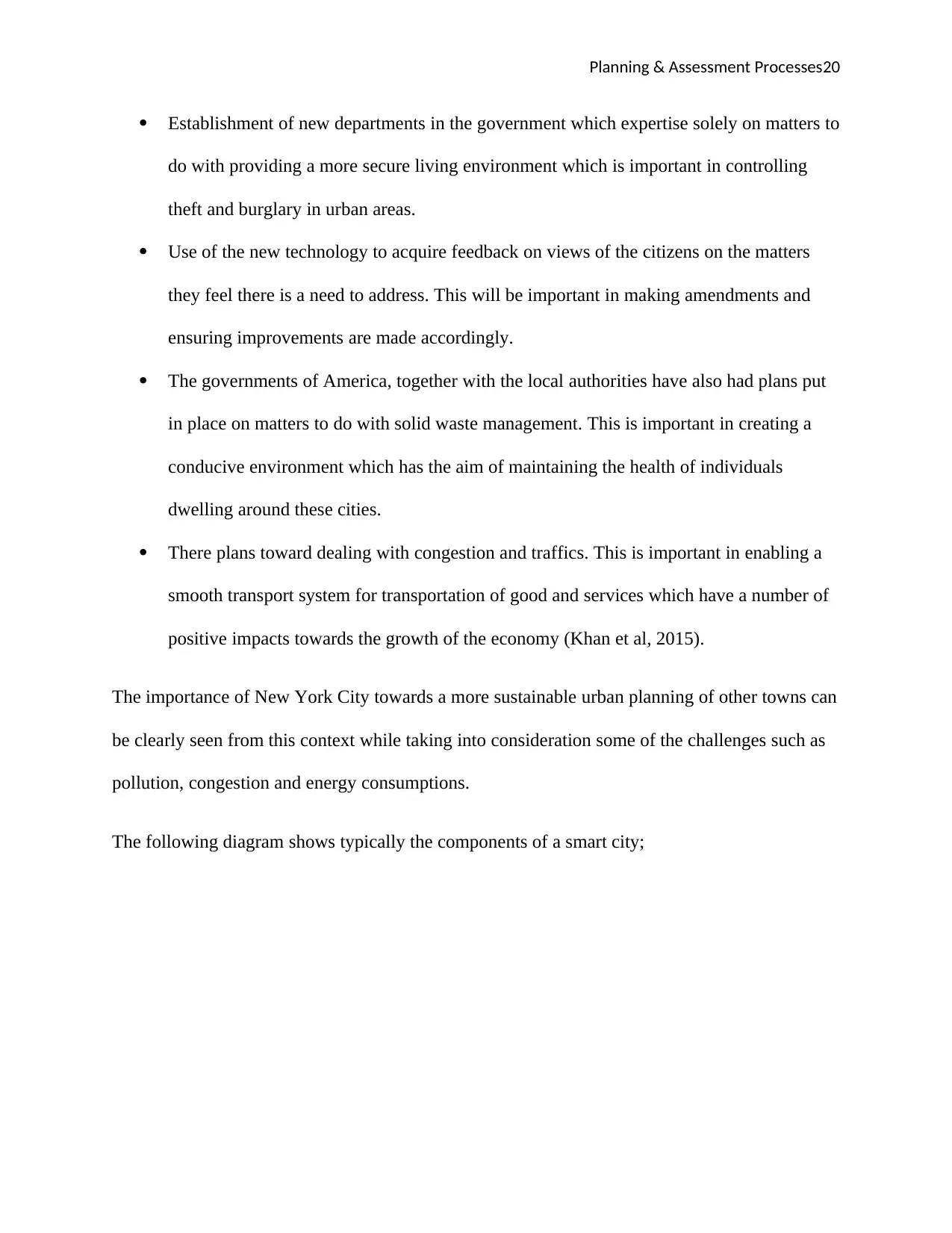
Planning & Assessment Processes20
Establishment of new departments in the government which expertise solely on matters to
do with providing a more secure living environment which is important in controlling
theft and burglary in urban areas.
Use of the new technology to acquire feedback on views of the citizens on the matters
they feel there is a need to address. This will be important in making amendments and
ensuring improvements are made accordingly.
The governments of America, together with the local authorities have also had plans put
in place on matters to do with solid waste management. This is important in creating a
conducive environment which has the aim of maintaining the health of individuals
dwelling around these cities.
There plans toward dealing with congestion and traffics. This is important in enabling a
smooth transport system for transportation of good and services which have a number of
positive impacts towards the growth of the economy (Khan et al, 2015).
The importance of New York City towards a more sustainable urban planning of other towns can
be clearly seen from this context while taking into consideration some of the challenges such as
pollution, congestion and energy consumptions.
The following diagram shows typically the components of a smart city;
Establishment of new departments in the government which expertise solely on matters to
do with providing a more secure living environment which is important in controlling
theft and burglary in urban areas.
Use of the new technology to acquire feedback on views of the citizens on the matters
they feel there is a need to address. This will be important in making amendments and
ensuring improvements are made accordingly.
The governments of America, together with the local authorities have also had plans put
in place on matters to do with solid waste management. This is important in creating a
conducive environment which has the aim of maintaining the health of individuals
dwelling around these cities.
There plans toward dealing with congestion and traffics. This is important in enabling a
smooth transport system for transportation of good and services which have a number of
positive impacts towards the growth of the economy (Khan et al, 2015).
The importance of New York City towards a more sustainable urban planning of other towns can
be clearly seen from this context while taking into consideration some of the challenges such as
pollution, congestion and energy consumptions.
The following diagram shows typically the components of a smart city;
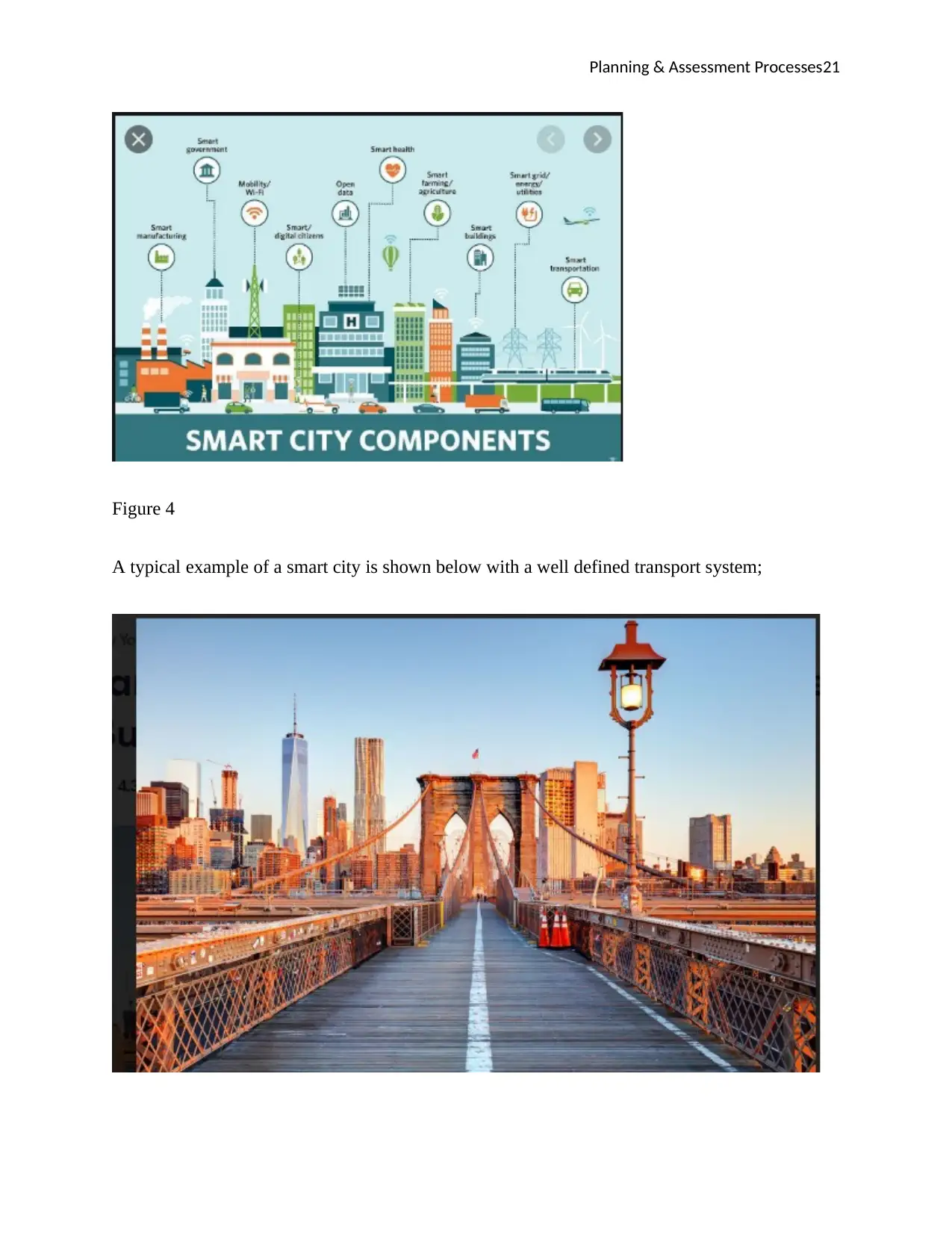
Planning & Assessment Processes21
Figure 4
A typical example of a smart city is shown below with a well defined transport system;
Figure 4
A typical example of a smart city is shown below with a well defined transport system;
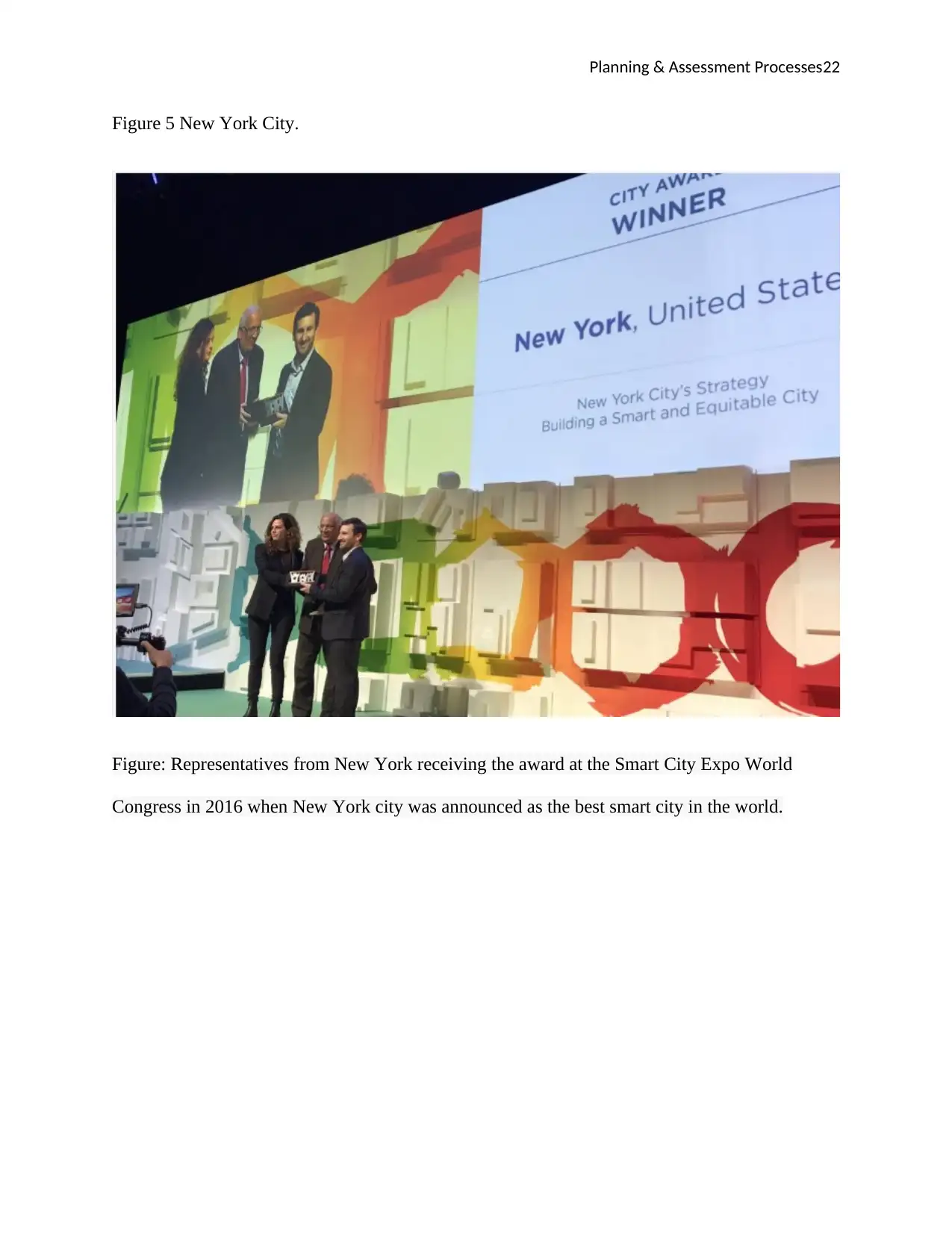
Planning & Assessment Processes22
Figure 5 New York City.
Figure: Representatives from New York receiving the award at the Smart City Expo World
Congress in 2016 when New York city was announced as the best smart city in the world.
Figure 5 New York City.
Figure: Representatives from New York receiving the award at the Smart City Expo World
Congress in 2016 when New York city was announced as the best smart city in the world.
Secure Best Marks with AI Grader
Need help grading? Try our AI Grader for instant feedback on your assignments.
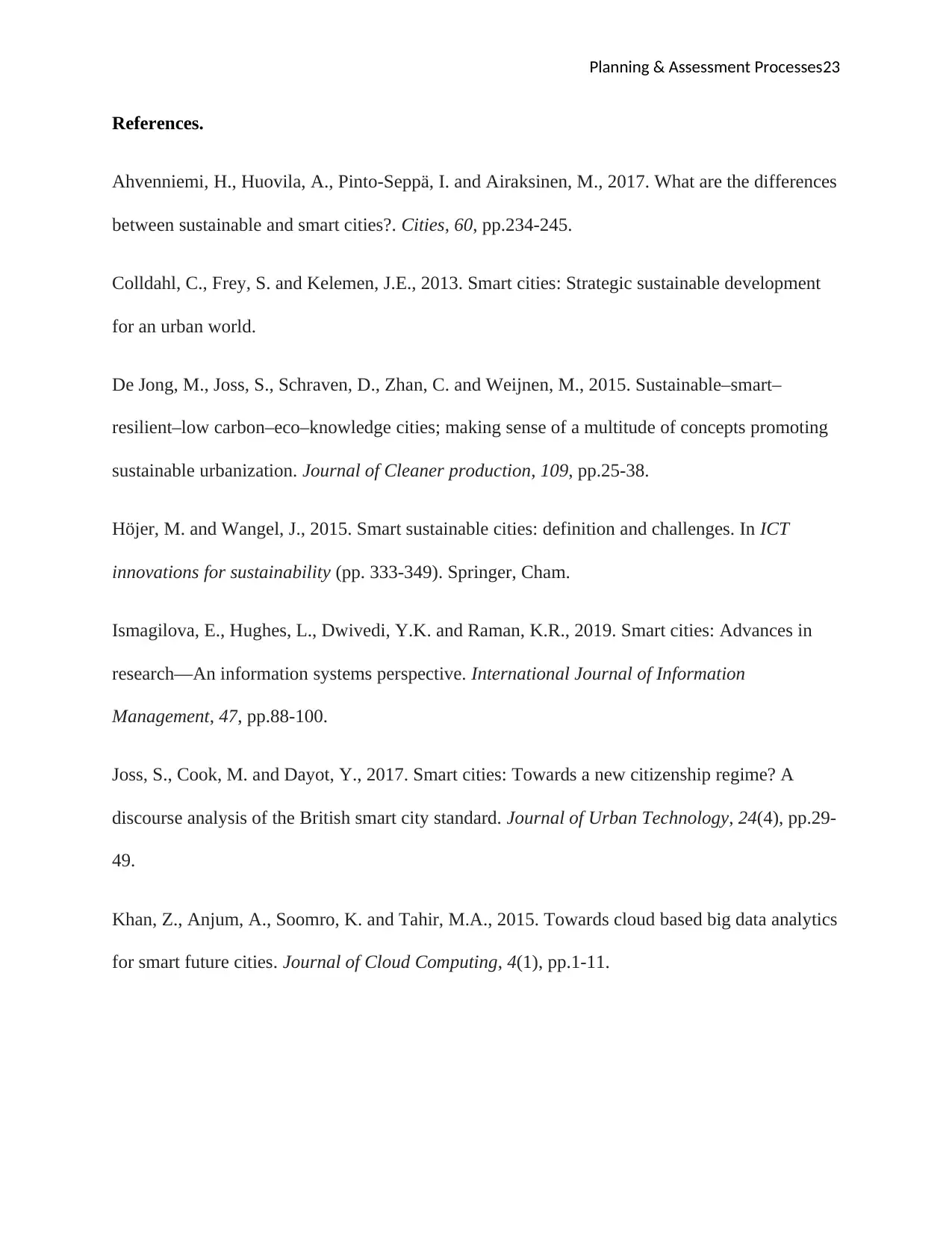
Planning & Assessment Processes23
References.
Ahvenniemi, H., Huovila, A., Pinto-Seppä, I. and Airaksinen, M., 2017. What are the differences
between sustainable and smart cities?. Cities, 60, pp.234-245.
Colldahl, C., Frey, S. and Kelemen, J.E., 2013. Smart cities: Strategic sustainable development
for an urban world.
De Jong, M., Joss, S., Schraven, D., Zhan, C. and Weijnen, M., 2015. Sustainable–smart–
resilient–low carbon–eco–knowledge cities; making sense of a multitude of concepts promoting
sustainable urbanization. Journal of Cleaner production, 109, pp.25-38.
Höjer, M. and Wangel, J., 2015. Smart sustainable cities: definition and challenges. In ICT
innovations for sustainability (pp. 333-349). Springer, Cham.
Ismagilova, E., Hughes, L., Dwivedi, Y.K. and Raman, K.R., 2019. Smart cities: Advances in
research—An information systems perspective. International Journal of Information
Management, 47, pp.88-100.
Joss, S., Cook, M. and Dayot, Y., 2017. Smart cities: Towards a new citizenship regime? A
discourse analysis of the British smart city standard. Journal of Urban Technology, 24(4), pp.29-
49.
Khan, Z., Anjum, A., Soomro, K. and Tahir, M.A., 2015. Towards cloud based big data analytics
for smart future cities. Journal of Cloud Computing, 4(1), pp.1-11.
References.
Ahvenniemi, H., Huovila, A., Pinto-Seppä, I. and Airaksinen, M., 2017. What are the differences
between sustainable and smart cities?. Cities, 60, pp.234-245.
Colldahl, C., Frey, S. and Kelemen, J.E., 2013. Smart cities: Strategic sustainable development
for an urban world.
De Jong, M., Joss, S., Schraven, D., Zhan, C. and Weijnen, M., 2015. Sustainable–smart–
resilient–low carbon–eco–knowledge cities; making sense of a multitude of concepts promoting
sustainable urbanization. Journal of Cleaner production, 109, pp.25-38.
Höjer, M. and Wangel, J., 2015. Smart sustainable cities: definition and challenges. In ICT
innovations for sustainability (pp. 333-349). Springer, Cham.
Ismagilova, E., Hughes, L., Dwivedi, Y.K. and Raman, K.R., 2019. Smart cities: Advances in
research—An information systems perspective. International Journal of Information
Management, 47, pp.88-100.
Joss, S., Cook, M. and Dayot, Y., 2017. Smart cities: Towards a new citizenship regime? A
discourse analysis of the British smart city standard. Journal of Urban Technology, 24(4), pp.29-
49.
Khan, Z., Anjum, A., Soomro, K. and Tahir, M.A., 2015. Towards cloud based big data analytics
for smart future cities. Journal of Cloud Computing, 4(1), pp.1-11.
1 out of 23
Related Documents
Your All-in-One AI-Powered Toolkit for Academic Success.
+13062052269
info@desklib.com
Available 24*7 on WhatsApp / Email
![[object Object]](/_next/static/media/star-bottom.7253800d.svg)
Unlock your academic potential
© 2024 | Zucol Services PVT LTD | All rights reserved.





